
© INTEL CORPORATION, 1997
December 1997
Order Number: 272771-002
EMBEDDED WRITE-BACK ENHANCED
IntelDX4TM PROCESSOR
Figure 1. Embedded Write-Back Enhanced IntelDX4TM
Processor Block Diagram
s
Up to 100 MHz Operation
s
Integrated Floating-Point Unit
s
Speed-Multiplying Technology
s
32-Bit RISC Technology Core
s
16-Kbyte Write-Back Cache
s
3.3 V Core Operation with 5 V Tolerant
I/O Buffers
s
Burst Bus Cycles
s
Dynamic Bus Sizing for 8- and 16-bit
Data Bus Devices
s
SL Technology
s
Data Bus Parity Generation and Checking
s
Boundary Scan (JTAG)
s
3.3-Volt Processor, 75 MHz, 25 MHz CLK
-- 208-Lead Shrink Quad Flat Pack (SQFP)
s
3.3-Volt Processor, 100 MHz, 33 MHz CLK
-- 208-Lead Shrink Quad Flat Pack (SQFP)
-- 168-Pin Pin Grid Array (PGA)
s
Binary Compatible with Large Software
Base
Paging
Unit
Prefetcher
32-Byte Code
Queue
2 x 16 Bytes
Code
Stream
Floating
Point Unit
Barrel
Shifter
24
Cache Unit
Burst Bus
Control
Bus Control
Write Buffers
4 x 32
64-Bit Interunit Transfer Bus
Register
File
ALU
Segmentation
Unit
Descriptor
Registers
Limit and
Attribute PLA
32
Base/
Index
Bus
Translation
Lookaside
Buffer
20
16 Kbyte
Cache
Clock
Multiplier
Floating
Point
Register File
Control &
Protection
Test Unit
Control
ROM
Address
Drivers
CLK
Core
Clock
32
Data Bus
Transceivers
32
Request
Sequencer
Bus Size
Control
Cache
Control
Parity
Generation
and Control
Boundary
Scan
Control
Bus Interface
D31-D0
A31-A2 BE3#- BE0#
ADS# W/R# D/C# M/IO# PCD
PWT RDY# LOCK# PLOCK#
BOFF# A20M# BREQ HOLD
HLDA RESET SRESET INTR
NMI SMI# SMIACT# FERR#
IGNNE# STPCLK#
BRDY# BLAST#
BS16# BS8#
KEN# FLUSH# AHOLD EADS#
CACHE# HITM# INV WB/WT#
TCK TMS TDI TDO
128
Instruction
Decode
32
Decoded
Instruction
Path
PCD
PWT
2
Physical
Address
32-Bit Data Bus
32-Bit Data Bus
Linear Address
Micro-
Instruction
Displacement Bus
PCHK# DP3-DP0
32
A3232-01
32
CLKMUL

Information in this document is provided in connection with Intel products. No license, express or implied, by
estoppel or otherwise, to any intellectual property rights is granted by this document. Except as provided in
Intel's Terms and Conditions of Sale for such products, Intel assumes no liability whatsoever, and Intel
disclaims any express or implied warranty, relating to sale and/or use of Intel products including liability or
warranties relating to fitness for a particular purpose, merchantability, or infringement of any patent, copyright
or other intellectual property right. Intel products are not intended for use in medical, life saving, or life
sustaining applications.
Intel may make changes to specifications and product descriptions at any time, without notice.
Designers must not rely on the absence or characteristics of any features or instructions marked "reserved" or
"undefined." Intel reserves these for future definition and shall have no responsibility whatsoever for conflicts or
incompatibilities arising from future changes to them.
The Embedded Write-Back Enhanced IntelDX4TM processor may contain design defects or errors known as
errata which may cause the product to deviate from published specifications. Current characterized errata are
available on request.
Contact your local Intel sales office or your distributor to obtain the latest specifications and before placing your
product order.
Copies of documents which have an ordering number and are referenced in this document, or other Intel
literature may be obtained by calling 1-800-548-4725 or by visiting Intel's website at http://www.intel.com.
Copyright © Intel Corporation, 1997
*Third-party brands and names are the property of their respective owners.

Contents
iii
EMBEDDED WRITE-BACK ENHANCED
IntelDX4TM PROCESSOR
1.0 INTRODUCTION ............................................................................................................. ........................... 1
1.1 Features ............................................................................................................................................. 1
1.2 Family Members ........................................................................................................... ...................... 2
2.0 HOW TO USE THIS DOCUMENT ................................................................................................. ............ 3
3.0 PIN DESCRIPTIONS ......................................................................................................... ........................ 3
3.1 Pin Assignments .......................................................................................................... ....................... 3
3.2 Pin Quick Reference ......................................................................................................................... 16
4.0 ARCHITECTURAL AND FUNCTIONAL OVERVIEW ............................................................................. 26
4.1 CPUID Instruction ............................................................................................................................. 26
4.1.1 Operation of the CPUID Instruction ....................................................................................... 26
4.2 Identification After Reset .................................................................................................................. 28
4.3 Boundary Scan (JTAG) .................................................................................................................... 28
4.3.1 Device Identification ............................................................................................................... 28
4.3.2 Boundary Scan Register Bits and Bit Order ........................................................................... 29
5.0 ELECTRICAL SPECIFICATIONS ........................................................................................................... 30
5.1 Maximum Ratings ............................................................................................................................. 30
5.2 DC Specifications ............................................................................................................................. 30
5.3 AC Specifications ............................................................................................................................. 33
5.4 Capacitive Derating Curves .............................................................................................................. 40
6.0 MECHANICAL DATA .............................................................................................................................. 42
6.1 Package Dimensions ........................................................................................................................ 42
6.2 Package Thermal Specifications ...................................................................................................... 44
FIGURES
Figure 1.
Embedded Write-Back Enhanced IntelDX4TM
Processor Block Diagram ................................... i
Figure 2.
Package Diagram for 208-Lead SQFP Embedded Write-Back Enhanced
IntelDX4TM Processor ................................................................................................................ 4
Figure 3.
Package Diagram for 168-Pin PGA Embedded Write-Back Enhanced
IntelDX4TM Processor .............................................................................................................. 10
Figure 4.
CLK Waveform ........................................................................................................................ 36
Figure 5.
Input Setup and Hold Timing ................................................................................................... 36
Figure 6.
Input Setup and Hold Timing ................................................................................................... 37
Figure 7.
PCHK# Valid Delay Timing ...................................................................................................... 37
Figure 8.
Output Valid Delay Timing ....................................................................................................... 38
Figure 9.
Maximum Float Delay Timing .................................................................................................. 38
Figure 10.
TCK Waveform ........................................................................................................................ 39
Figure 11.
Test Signal Timing Diagram .................................................................................................... 39

Contents
iv
Figure 12.
Typical Loading Delay versus Load Capacitance under Worst-Case Conditions
for a Low-to-High Transition ..................................................................................................... 40
Figure 13.
Typical Loading Delay versus Load Capacitance under Worst-Case Conditions
for a High-to-Low Transition ..................................................................................................... 40
Figure 14.
Typical Loading Delay versus Load Capacitance in Mixed Voltage System ........................... 41
Figure 15.
208-Lead SQFP Package Dimensions .................................................................................... 42
Figure 16.
Principal Dimensions and Data for 168-Pin Grid Array Package ............................................. 43
TABLES
Table 1.
The Embedded Write-Back Enhanced IntelDX4TM Processor Family ....................................... 2
Table 2.
Pinout Differences for 208-Lead SQFP Package ...................................................................... 5
Table 3.
Pin Assignment for 208-Lead SQFP Package ........................................................................... 6
Table 4.
Pin Cross Reference for 208-Lead SQFP Package ................................................................... 8
Table 5.
Pinout Differences for 168-Pin PGA Package ......................................................................... 11
Table 6.
Pin Assignment for 168-Pin PGA Package .............................................................................. 12
Table 7.
Pin Cross Reference for 168-Pin PGA Package ...................................................................... 14
Table 8.
Embedded Write-Back Enhanced IntelDX4TM Processor Pin Descriptions ............................. 16
Table 9.
Output Pins .............................................................................................................................. 24
Table 10.
Input/Output Pins ..................................................................................................................... 24
Table 11.
Test Pins .................................................................................................................................. 25
Table 12.
Input Pins ................................................................................................................................. 25
Table 13.
CPUID Instruction Description ................................................................................................. 26
Table 14.
Boundary Scan Component Identification Code (Write-Through/Standard Bus Mode) ........... 28
Table 15.
Boundary Scan Component Identification Code (Write-Back/Enhanced Bus Mode) ............... 29
Table 16.
Absolute Maximum Ratings ..................................................................................................... 30
Table 17.
Operating Supply Voltages ...................................................................................................... 30
Table 18.
DC Specifications ..................................................................................................................... 31
Table 19.
I
CC
Values ................................................................................................................................ 32
Table 20.
AC Characteristics ................................................................................................................... 33
Table 21.
AC Specifications for the Test Access Port ............................................................................. 35
Table 22.
168-Pin Ceramic PGA Package Dimensions ........................................................................... 43
Table 23.
Ceramic PGA Package Dimension Symbols ........................................................................... 44
Table 24.
Thermal Resistance,
JA
(
∞
C/W) ............................................................................................. 45
Table 25.
Thermal Resistance,
JC
(
∞
C/W) ............................................................................................. 45
Table 26.
Maximum T
ambient
, T
A
max (
∞
C) ............................................................................................... 45

Embedded Write-Back Enhanced IntelDX4TM Processor
1
1.0
INTRODUCTION
The embedded Write-Back Enhanced IntelDX4TM
processor provides high performance to 32-bit,
embedded applications. Designed for applications
that need a floating-point unit, the processor is ideal
for embedded designs running DOS*, Microsoft
Windows*, OS/2*, or UNIX* applications written for
the Intel architecture. Projects can be completed
quickly using the wide range of software tools,
utilities, assemblers and compilers that are available
for desktop computer systems. Also, developers can
find advantages in using existing chipsets and
peripheral components in their embedded designs.
The Embedded Write-Back Enhanced IntelDX4
processor is binary compatible with the Intel386TM
and earlier Intel processors. Compared with the
Intel386 processor, it provides faster execution of
many commonly-used instructions. It also provides
the benefits of an integrated, 16-Kbyte, write-back
cache for code and data. Its data bus can operate in
burst mode which provides up to 106-Mbyte-per-
second transfers for cache-line fills and instruction
prefetches.
Intel's SL technology is incorporated in the
Embedded Write-Back Enhanced IntelDX4
processor. Utilizing Intel's System Management
Mode (SMM) enables designers to develop energy-
efficient systems.
Two component packages are available:
∑ 168-pin Pin Grid Array (PGA)
∑ 208-lead Shrink Quad Flat Pack (SQFP)
The processor operates at either two or three times
the external bus frequency. At two times the external
bus frequency the processor operates up to 66 MHz,
(33-MHz CLK). At three times the external bus
frequency the processor operates up to 100 MHz
(33-MHz CLK).
1.1
Features
The Embedded Write-Back Enhanced IntelDX4
processor offers these features:
∑ 32-bit RISC-Technology Core -- The Embedded
Write-Back Enhanced IntelDX4 processor
performs a complete set of arithmetic and logical
operations on 8-, 16-, and 32-bit data types using
a full-width ALU and eight general purpose
registers.
∑ Single Cycle Execution -- Many instructions
execute in a single clock cycle.
∑ Instruction Pipelining -- Overlapped instruction
fetching, decoding, address translation and
execution.
∑ On-Chip Floating-Point Unit -- Intel486TM
processors support the 32-, 64-, and 80-bit formats
specified in IEEE standard 754. The unit is binary
compatible with the 8087, Intel287TM, Intel387TM
coprocessors, and Intel OverDrive
Æ
processor.
∑ On-Chip Cache with Cache Consistency
Support -- A 16-Kbyte internal cache is used for
both data and instructions. It is configurable to be
write-back or write-through on a line-by-line basis.
The internal cache implements a modified MESI
protocol, which is applicable to uniprocessor
systems. Cache hits provide zero wait-state
access times for data within the cache. Bus activity
is tracked to detect alterations in the memory
represented by the internal cache. The internal
cache can be invalidated or flushed so that an
external cache controller can maintain cache
consistency.
∑ External Cache Control -- Write-back and flush
controls for an external cache are provided so the
processor can maintain cache consistency.
∑ On-Chip Memory Management Unit -- Address
management and memory space protection
mechanisms maintain the integrity of memory in a
multitasking and virtual memory environment. Both
memory segmentation and paging are supported.
∑ Burst Cycles -- Burst transfers allow a new
double-word to be read from memory on each bus
clock cycle. This capability is especially useful for
instruction prefetch and for filling the internal
cache. Data written from the processor to memory
can also be burst transfers.
∑ Write Buffers -- The processor contains four
write buffers to enhance the performance of
consecutive writes to memory. The processor can
continue internal operations after a write to these
buffers, without waiting for the write to be
completed on the external bus.
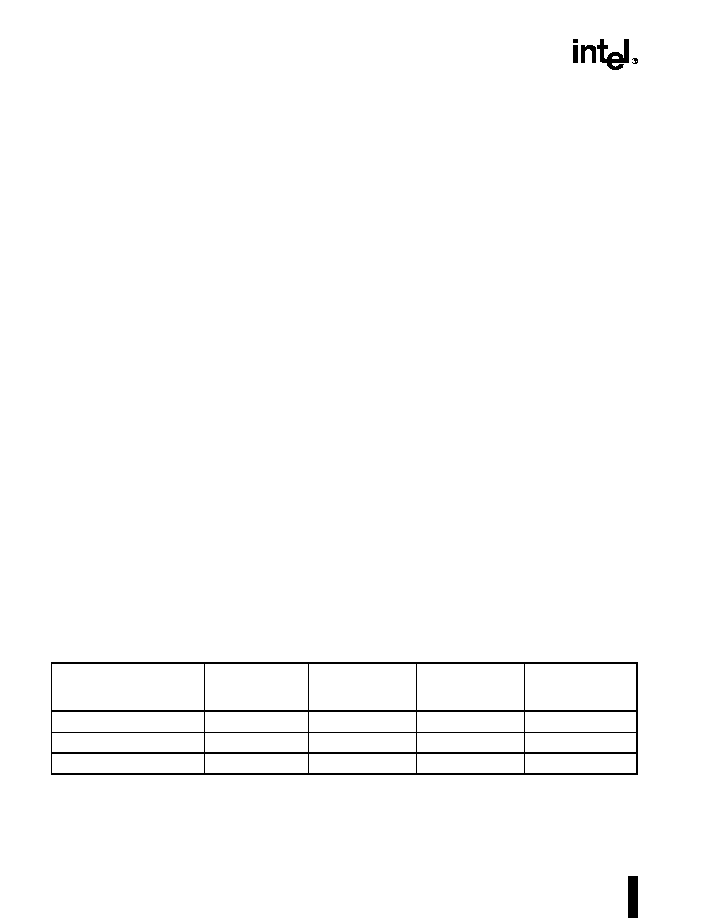
2
Embedded Write-Back Enhanced IntelDX4TM Processor
∑ Bus Backoff -- When another bus master needs
control of the bus during a processor initiated bus
cycle, the Embedded Write-Back Enhanced
IntelDX4 processor floats its bus signals, then
restarts the cycle when the bus becomes available
again.
∑ Instruction Restart -- Programs can continue
execution following an exception generated by an
unsuccessful attempt to access memory. This
feature is important for supporting demand-paged
virtual memory applications.
∑ Dynamic Bus Sizing -- External controllers can
dynamically alter the effective width of the data
bus. Bus widths of 8, 16, or 32 bits can be used.
∑ Boundary Scan (JTAG) -- Boundary Scan
provides in-circuit testing of components on
printed circuit boards. The Intel Boundary Scan
implementation conforms with the IEEE Standard
Test Access Port and Boundary Scan Architecture.
∑ Enhanced Bus Mode -- The definitions of some
signals have been changed to support write-back
cache mode.
Intel's SL technology provides these features:
∑ Intel System Management Mode (SMM) -- A
unique Intel architecture operating mode provides
a dedicated special purpose interrupt and address
space that can be used to implement intelligent
power management and other enhanced functions
in a manner that is completely transparent to the
operating system and applications software.
∑ I/O Restart -- An I/O instruction interrupted by a
System Management Interrupt (SMI#) can
automatically be restarted following the execution
of the RSM instruction.
∑ Stop Clock -- The Embedded Write-Back
Enhanced IntelDX4 processor has a stop clock
control mechanism that provides two low-power
states: a Stop Grant state (20≠50 mA typical,
depending on input clock frequency) and a Stop
Clock state (~600
µ
A typical, with input clock
frequency of 0 MHz).
∑ Auto HALT Power Down -- After the execution of
a HALT instruction, the Embedded Write-Back
Enhanced IntelDX4 processor issues a normal
Halt bus cycle and the clock input to the processor
core is automatically stopped, causing the
processor to enter the Auto HALT Power Down
state (20≠50 mA typical, depending on input clock
frequency).
∑ Auto Idle Power Down -- This function allows the
processor to reduce the core frequency to the bus
frequency when both the core and bus are idle.
Auto Idle Power Down is software transparent and
does not affect processor performance. Auto Idle
Power Down provides an average power savings
of 10% and is only applicable to clock multiplied
processors.
1.2
Family Members
Table 1 shows the Embedded Write-Back Enhanced
IntelDX4 processors and briefly describes their
characteristics.
Table 1. The Embedded Write-Back Enhanced IntelDX4TM Processor Family
Product
Supply Voltage
V
CC
Maximum
Processor
Frequency
Maximum
External Bus
Frequency
Package
FC80486DX4WB75
3.3 V
75
MHz
25
MHz
208-Lead SQFP
FC80486DX4WB100
3.3 V
100
MHz
33
MHz
208-Lead SQFP
A80486DX4WB100
3.3 V
100
MHz
33
MHz
168-Pin PGA

Embedded Write-Back Enhanced IntelDX4TM Processor
3
2.0
HOW TO USE THIS DOCUMENT
For a complete set of documentation related to the
Embedded Write-Back Enhanced IntelDX4
processor, use this document in conjunction with the
following reference documents:
∑
Embedded Intel486TM Processor Family
Developer's Manual
-- Order No. 273021
∑
Embedded Intel486TM Processor Hardware
Reference Manual
-- Order No. 273025
∑
Intel486 Microprocessor Family Programmer's
Reference Manual
-- Order No. 240486
∑ Intel Application Note AP-485 --
Intel Processor
Identification with the CPUID Instruction
--
Order No. 241618
The information in the reference documents for the
IntelDX4 processor applies to the Embedded Write-
Back Enhanced IntelDX4 processor. Some of the
IntelDX4 processor information is duplicated in this
document to minimize the dependence on the
reference documents.
3.0
PIN DESCRIPTIONS
3.1
Pin Assignments
The following figures and tables show the pin assign-
ments of each package type for the Embedded
Write-Back Enhanced IntelDX4 processor. Tables
are provided showing the pin differences between
the Embedded Write-Back Enhanced IntelDX4
processor and other embedded Intel486 processor
products.
208-Lead SQFP - Quad Flat Pack
∑ Figure 2, Package Diagram for 208-Lead SQFP
Embedded Write-Back Enhanced IntelDX4TM
Processor (pg. 4)
∑ Table 2, Pinout Differences for 208-Lead SQFP
Package (pg. 5)
∑ Table 3, Pin Assignment for 208-Lead SQFP
Package (pg. 6)
∑ Table 4, Pin Cross Reference for 208-Lead SQFP
Package (pg. 8)
168-Pin PGA - Pin Grid Array
∑ Figure 3, Package Diagram for 168-Pin PGA
Embedded Write-Back Enhanced IntelDX4TM
Processor (pg. 10)
∑ Table 5, Pinout Differences for 168-Pin PGA
Package (pg. 11)
∑ Table 6, Pin Assignment for 168-Pin PGA
Package (pg. 12)
∑ Table 7, Pin Cross Reference for 168-Pin PGA
Package (pg. 14)

Embedded Write-Back Enhanced IntelDX4TM Processor
4
Figure 2. Package Diagram for 208-Lead SQFP Embedded Write-Back Enhanced IntelDX4TM Processor
156
155
154
153
152
151
150
149
148
147
146
145
144
143
142
141
140
139
138
137
136
135
134
133
132
131
130
129
128
127
126
125
124
123
122
121
120
119
118
117
116
115
114
113
112
111
110
109
108
107
106
105
208-Lead SQFP
Embedded Write-Back Enhanced
IntelDX4TM Processor
Top View
1
2
3
4
5
6
7
8
9
10
11
12
13
14
15
16
17
18
19
20
21
22
23
24
25
26
27
28
29
30
31
32
33
34
35
36
37
38
39
40
41
42
43
44
45
46
47
48
49
50
51
52
53
54
55
56
57
58
59
60
61
62
63
64
65
66
67
68
69
70
71
72
73
74
75
76
77
78
79
80
81
82
83
84
85
86
87
88
89
90
91
92
93
94
95
96
97
98
99
100
101
102
103
104
208
207
206
205
204
203
202
201
200
199
198
197
196
195
194
193
192
191
190
189
188
187
186
185
184
183
182
181
180
179
178
177
176
175
174
173
172
171
170
169
168
167
166
165
164
163
162
161
160
159
158
157
V
SS
LOCK#
PLOCK# V
CC
BLAST#
ADS# A2 V
SS
V
CC
V
SS
V
CC
A3
A4
A5
RESERVED#
A6
A7 V
CC
A8 V
SS
V
CC
A9 A10
V
CC
V
SS
V
CC
A11
V
SS
A12
V
CC
A13 A14
V
CC
V
SS
A15 A16
V
CC
A17 V
SS
V
CC
TDI
TMS
A18
A19
A20 V
CC
V
CC
A21
A22
A23
A24
V
SS
V
SS
V
CC
V
CC5
PCHK#
BRDY#
BOFF#
BS16#
BS8#
V
CC
V
SS
CLKMUL
RDY#
KEN#
V
CC
V
SS
HOLD
AHOLD
TCK
V
CC
V
CC
V
SS
V
CC
V
CC
CLK
V
CC
HLDA
W/R#
V
SS
V
CC
BREQ
BE0#
BE1#
BE2#
BE3#
V
CC
V
SS
M/IO#
V
CC
D/C#
PWT
PCD
V
CC
V
SS
V
CC
V
CC
EADS#
A20M#
RESET
FLUSH#
INTR
NMI
V
SS
V
SS
V
CC
A25
A26
A27
A28
V
CC
A29
A30
A31
V
SS
DP0
D0
D1
D2
D3
D4
V
CC
V
SS
V
CC
V
CC
V
SS
V
CC
V
CC
V
SS
V
CC
D5
D6
V
CC
NC
D7
DP1
D8
D9
V
SS
V
CC
V
SS
D10
D11
D12
D13
V
SS
V
CC
D14
D15
V
CC
V
SS
DP2
D16
V
SS
V
CC
V
SS
V
SS
V
CC
V
SS
V
CC
V
SS
SRESET
SMIACT#
V
CC
V
SS
V
CC
HITM#
WB/WT#
SMI#
FERR#
NC
TDO
V
CC
CACHE#
INV
IGNNE#
STPCLK#
D31
D30
V
SS
V
CC
D29
D28
V
CC
V
SS
V
CC
D27
D26
D25
V
CC
D24
V
SS
V
CC
DP3
D23
D22
D21
V
SS
V
CC
NC
V
SS
V
CC
D20
D19
D18
V
CC
D17
V
SS
A3230-01

Embedded Write-Back Enhanced IntelDX4TM Processor
5
Table 2. Pinout Differences for 208-Lead SQFP Package
Pin #
Embedded
Intel486TM SX
Processor
Embedded
IntelDX2TM
Processor
Embedded Write-Back
Enhanced IntelDX4TM
Processor
3
V
CC
1
V
CC
V
CC5
11
INC
2
INC
CLKMUL
63
INC
INC
HITM#
64
INC
INC
WB/WT#
66
INC
FERR#
FERR#
70
INC
INC
CACHE#
71
INC
INC
INV
72
INC
IGNNE#
IGNNE#
NOTES:
1. This pin location is for the V
CC5
pin on the embedded IntelDX4 processor. For compatibility with 3.3V processors that
have 5V-tolerant input buffers (i.e., embedded IntelDX4 processors), this pin should be connected to a V
CC
trace, not to
the V
CC
plane.
2. INC. Internal No Connect. These pins are not connected to any internal pad. However, signals are defined for the loca-
tion of the INC pins in the embedded IntelDX4 processor. One system design can accommodate any one of these pro-
cessors provided the purpose of each INC pin is understood before it is used.

Embedded Write-Back Enhanced IntelDX4TM Processor
6
Table 3. Pin Assignment for 208-Lead SQFP Package (Sheet 1 of 2)
Pin#
Description
Pin#
Description
Pin#
Description
Pin#
Description
1
V
SS
53
V
SS
105
V
SS
157
V
SS
2
V
CC
54
V
CC
106
V
CC
158
A24
3
V
CC
5
55
V
SS
107
V
SS
159
A23
4
PCHK#
56
V
CC
108
D16
160
A22
5
BRDY#
57
V
SS
109
DP2
161
A21
6
BOFF#
58
SRESET
110
V
SS
162
V
CC
7
BS16#
59
SMIACT#
111
V
CC
163
V
CC
8
BS8#
60
V
CC
112
D15
164
A20
9
V
CC
61
V
SS
113
D14
165
A19
10
V
SS
62
V
CC
114
V
CC
166
A18
11
CLKMUL
63
HITM#
115
V
SS
167
TMS
12
RDY#
64
WB/WT#
116
D13
168
TDI
13
KEN#
65
SMI#
117
D12
169
V
CC
14
V
CC
66
FERR#
118
D11
170
V
SS
15
V
SS
67
NC
1
119
D10
171
A17
16
HOLD
68
TDO
120
V
SS
172
V
CC
17
AHOLD
69
V
CC
121
V
CC
173
A16
18
TCK
70
CACHE#
122
V
SS
174
A15
19
V
CC
71
INV
123
D9
175
V
SS
20
V
CC
72
IGNNE#
124
D8
176
V
CC
21
V
SS
73
STPCLK#
125
DP1
177
A14
22
V
CC
74
D31
126
D7
178
A13
23
V
CC
75
D30
127
NC
1
179
V
CC
24
CLK
76
V
SS
128
V
CC
180
A12
25
V
CC
77
V
CC
129
D6
181
V
SS
26
HLDA
78
D29
130
D5
182
A11
27
W/R#
79
D28
131
V
CC
183
V
CC
28
V
SS
80
V
CC
132
V
SS
184
V
SS
29
V
CC
81
V
SS
133
V
CC
185
V
CC
30
BREQ
82
V
CC
134
V
CC
186
A10
31
BE0#
83
D27
135
V
SS
187
A9
32
BE1#
84
D26
136
V
CC
188
V
CC
33
BE2#
85
D25
137
V
CC
189
V
SS
34
BE3#
86
V
CC
138
V
SS
190
A8
35
V
CC
87
D24
139
V
CC
191
V
CC

Embedded Write-Back Enhanced IntelDX4TM Processor
7
36
V
SS
88
V
SS
140
D4
192
A7
37
M/IO#
89
V
CC
141
D3
193
A6
38
V
CC
90
DP3
142
D2
194
RESERVED#
39
D/C#
91
D23
143
D1
195
A5
40
PWT
92
D22
144
D0
196
A4
41
PCD
93
D21
145
DP0
197
A3
42
V
CC
94
V
SS
146
V
SS
198
V
CC
43
V
SS
95
V
CC
147
A31
199
V
SS
44
V
CC
96
NC
1
148
A30
200
V
CC
45
V
CC
97
V
SS
149
A29
201
V
SS
46
EADS#
98
V
CC
150
V
CC
202
A2
47
A20M#
99
D20
151
A28
203
ADS#
48
RESET
100
D19
152
A27
204
BLAST#
49
FLUSH#
101
D18
153
A26
205
V
CC
50
INTR
102
V
CC
154
A25
206
PLOCK#
51
NMI
103
D17
155
V
CC
207
LOCK#
52
V
SS
104
V
SS
156
V
SS
208
V
SS
NOTE:
1. NC. Do Not Connect. These pins should always remain unconnected. Connection of NC pins to V
CC
, or V
SS
or to any other
signal can result in component malfunction or incompatibility with future steppings of the Intel486 processors.
Table 3. Pin Assignment for 208-Lead SQFP Package (Sheet 2 of 2)
Pin#
Description
Pin#
Description
Pin#
Description
Pin#
Description

Embedded Write-Back Enhanced IntelDX4TM Processor
8
Table 4. Pin Cross Reference for 208-Lead SQFP Package (Sheet 1 of 2)
Address
Pin #
Data
Pin #
Control
Pin #
NC
V
CC5
V
CC
V
SS
A2
202
D0
144
A20M#
47
67
3
2
1
A3
197
D1
143
ADS#
203
96
9
10
A4
196
D2
142
AHOLD
17
127
14
15
A5
195
D3
141
BE0#
31
19
21
A6
193
D4
140
BE1#
32
20
28
A7
192
D5
130
BE2#
33
22
36
A8
190
D6
129
BE3#
34
23
43
A9
187
D7
126
BLAST#
204
25
52
A10
186
D8
124
BOFF#
6
29
53
A11
182
D9
123
BRDY#
5
35
55
A12
180
D10
119
BREQ
30
38
57
A13
178
D11
118
BS16#
7
42
61
A14
177
D12
117
BS8#
8
44
76
A15
174
D13
116
CACHE#
70
45
81
A16
173
D14
113
CLK
24
54
88
A17
171
D15
112
CLKMUL
11
56
94
A18
166
D16
108
D/C#
39
60
97
A19
165
D17
103
DP0
145
62
104
A20
164
D18
101
DP1
125
69
105
A21
161
D19
100
DP2
109
77
107
A22
160
D20
99
DP3
90
80
110
A23
159
D21
93
EADS#
46
82
115
A24
158
D22
92
FERR#
66
86
120
A25
154
D23
91
FLUSH#
49
89
122
A26
153
D24
87
HITM#
63
95
132
A27
152
D25
85
HLDA
26
98
135
A28
151
D26
84
HOLD
16
102
138
A29
149
D27
83
IGNNE#
72
106
146
A30
148
D28
79
INTR
50
111
156
A31
147
D29
78
INV
71
114
157
D30
75
KEN#
13
121
170
D31
74
LOCK#
207
128
175
M/IO#
37
131
181

Embedded Write-Back Enhanced IntelDX4TM Processor
9
NMI
51
133
184
PCD
41
134
189
PCHK#
4
136
199
PLOCK#
206
137
201
PWT
40
139
208
RDY#
12
150
RESERVED#
194
155
RESET
48
162
SMI#
65
163
SMIACT#
59
169
SRESET
58
172
STPCLK#
73
176
TCK
18
179
TDI
168
183
TDO
68
185
TMS
167
188
WB/WT#
64
191
W/R#
27
198
200
205
Table 4. Pin Cross Reference for 208-Lead SQFP Package (Sheet 2 of 2)
Address
Pin #
Data
Pin #
Control
Pin #
NC
V
CC5
V
CC
V
SS
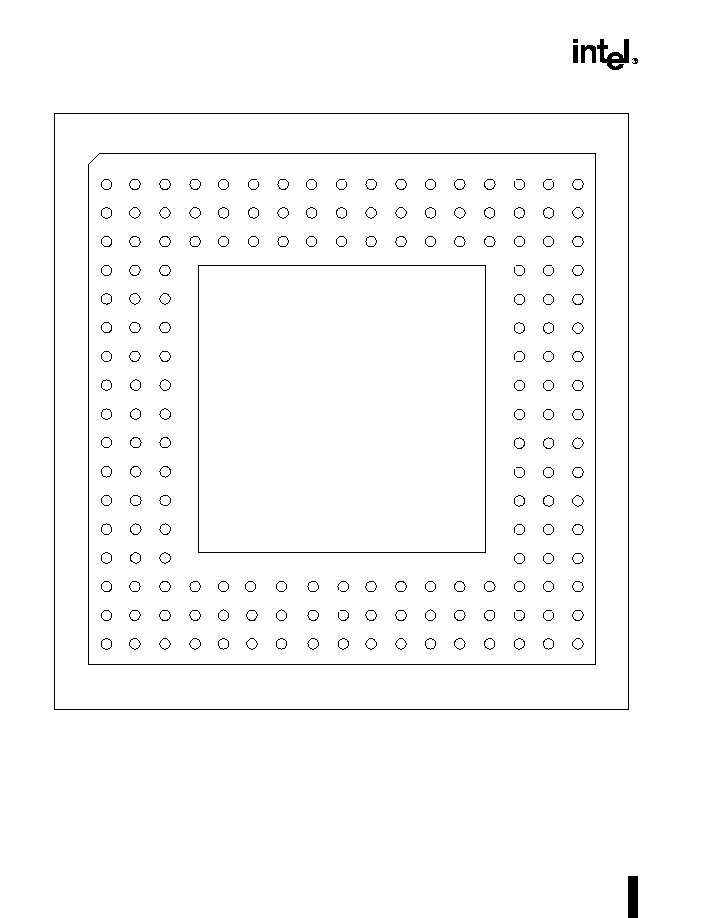
Embedded Write-Back Enhanced IntelDX4TM Processor
10
Figure 3. Package Diagram for 168-Pin PGA Embedded Write-Back Enhanced IntelDX4TM Processor
A3231-01
D20
A
D19
B
D11
C
D22
D21
D18
D9
D
V
SS
E
D13
V
CC
DP1
F
V
SS
G
D8
V
CC
V
SS
H
V
CC5
J
D3
D5
V
SS
K
V
SS
L
V
CC
D6
V
SS
M
D2
N
V
CC
D1
D0
P
A31
Q
A29
V
SS
A28
R
A27
S
A25
A26
1
2
1
2
TCK
V
SS
CLK
D17
D10
D15
D12
DP2
D16
D14
D7
D4
DP0
A30
A17
V
CC
A23
3
3
D23
V
SS
V
CC
A19
V
SS
VOLDET
4
5
4
5
6
6
7
8
7
8
9
9
10
11
10
11
12
12
13
13
14
14
15
16
15
16
17
17
DP3
V
SS
V
CC
D24
D25
D27
V
SS
V
CC
D26
A21
A18
A14
A24
V
CC
V
SS
A22
A15
A12
A20
A16
A13
A9
A5
A11
V
SS
A7
A8
A10
A2
V
CC
V
SS
D29
D31
D28
V
SS
V
CC
D30
INV
SMI#
SRESET
RESERVED#
HITM# CACHE# SMIACT#
INC
WB/WT#
NC
TDI
TMS
FERR#
IGNNE#
NMI
FLUSH# A20M# HOLD KEN# STPCLK# BRDY#
BE2#
BE0#
PWT
D/C#
LOCK#
HLDA
BREQ
A3
A6
INTR
TDO
RESET
BS8#
RDY#
BE1#
M/IO#
PLOCK# BLAST#
A4
AHOLD EADS# BS16# BOFF#
BE3#
PCD
W/R#
PCHK# CLKMUL ADS#
A
B
C
D
E
F
G
H
J
K
L
M
N
P
Q
R
S
V
CC
V
SS
V
CC
V
SS
V
CC
V
SS
V
CC
V
SS
V
SS
V
CC
V
CC
V
CC
V
CC
V
CC
V
CC
V
CC
V
CC
V
SS
V
SS
V
SS
V
SS
V
SS
V
SS
V
SS
168-Pin PGA
Embedded Write-Back Enhanced
IntelDX4TM Processor
Pin Side View

Embedded Write-Back Enhanced IntelDX4TM Processor
11
Table 5. Pinout Differences for 168-Pin PGA Package
Pin #
Embedded IntelDX2TM Processor
Embedded Write-Back Enhanced
IntelDX4TM Processor
A10
INC INV
A12
INC HITM#
B12
INC
CACHE#
B13
INC
WB/WT#
J1
V
CC
V
CC5
R17
INC
CLKMUL
S4
NC
VOLDET

Embedded Write-Back Enhanced IntelDX4TM Processor
12
Table 6. Pin Assignment for 168-Pin PGA Package (Sheet 1 of 2)
Pin #
Description
Pin #
Description
Pin #
Description
A1
D20
D17
BOFF#
P2
A29
A2
D22
E1
V
SS
P3
A30
A3
TCK
E2
V
CC
P15
HLDA
A4
D23
E3
D10
P16
V
CC
A5
DP3
E15
HOLD
P17
V
SS
A6
D24
E16
V
CC
Q1
A31
A7
V
SS
E17
V
SS
Q2
V
SS
A8
D29
F1
DP1
Q3
A17
A9
V
SS
F2
D8
Q4
A19
A10
INV
F3
D15
Q5
A21
A11
V
SS
F15
KEN#
Q6
A24
A12
HITM#
F16
RDY#
Q7
A22
A13
INC
F17
BE3#
Q8
A20
A14
TDI
G1
V
SS
Q9
A16
A15
IGNNE#
G2
V
CC
Q10
A13
A16
INTR
G3
D12
Q11
A9
A17
AHOLD
G15
STPCLK#
Q12
A5
B1
D19
G16
V
CC
Q13
A7
B2
D21
G17
V
SS
Q14
A2
B3
V
SS
H1
V
SS
Q15
BREQ
B4
V
SS
H2
D3
Q16
PLOCK#
B5
V
SS
H3
DP2
Q17
PCHK#
B6
D25
H15
BRDY#
R1
A28
B7
V
CC
H16
V
CC
R2
A25
B8
D31
H17
V
SS
R3
V
CC
B9
V
CC
J1
V
CC5
R4
V
SS
B10
SMI#
J2
D5
R5
A18
B11
V
CC
J3
D16
R6
V
CC
B12
CACHE#
J15
BE2#
R7
A15
B13
WB/WT#
J16
BE1#
R8
V
CC
B14
TMS
J17
PCD
R9
V
CC
B15
NMI
K1
V
SS
R10
V
CC
B16
TDO
K2
V
CC
R11
V
CC
B17
EADS#
K3
D14
R12
A11
C1
D11
K15
BE0#
R13
A8
C2
D18
K16
V
CC
R14
V
CC
C3
CLK
K17
V
SS
R15
A3
C4
V
CC
L1
V
SS
R16
BLAST#
C5
V
CC
L2
D6
R17
CLKMUL

Embedded Write-Back Enhanced IntelDX4TM Processor
13
C6
D27
L3
D7
S1
A27
C7
D26
L15
PWT
S2
A26
C8
D28
L16
V
CC
S3
A23
C9
D30
L17
V
SS
S4
VOLDET
C10
SRESET
M1
V
SS
S5
A14
C11
RESERVED#
M2
V
CC
S6
V
SS
C12
SMIACT#
M3
D4
S7
A12
C13
NC
M15
D/C#
S8
V
SS
C14
FERR#
M16
V
CC
S9
V
SS
C15
FLUSH#
M17
V
SS
S10
V
SS
C16
RESET
N1
D2
S11
V
SS
C17
BS16#
N2
D1
S12
V
SS
D1
D9
N3
DP0
S13
A10
D2
D13
N15
LOCK#
S14
V
SS
D3
D17
N16
M/IO#
S15
A6
D15
A20M#
N17
W/R#
S16
A4
D16
BS8#
P1
D0
S17
ADS#
Table 6. Pin Assignment for 168-Pin PGA Package (Sheet 2 of 2)
Pin #
Description
Pin #
Description
Pin #
Description

Embedded Write-Back Enhanced IntelDX4TM Processor
14
Table 7. Pin Cross Reference for 168-Pin PGA Package (Sheet 1 of 2)
Addres
s
Pin #
Data
Pin #
Control
Pin #
NC
INC
Vcc5
Vcc
Vss
A2
Q14
D0
P1
A20M#
D15
C13
A13
J1
B7
A7
A3
R15
D1
N2
ADS#
S17
B9
A9
A4
S16
D2
N1
AHOLD
A17
B11
A11
A5
Q12
D3
H2
BE0#
K15
C4
B3
A6
S15
D4
M3
BE1#
J16
C5
B4
A7
Q13
D5
J2
BE2#
J15
E2
B5
A8
R13
D6
L2
BE3#
F17
E16
E1
A9
Q11
D7
L3
BLAST#
R16
G2
E17
A10
S13
D8
F2
BOFF#
D17
G16
G1
A11
R12
D9
D1
BRDY#
H15
H16
G17
A12
S7
D10
E3
BREQ
Q15
K2
H1
A13
Q10
D11
C1
BS16#
C17
K16
H17
A14
S5
D12
G3
BS8#
D16
L16
K1
A15
R7
D13
D2
CLK
C3
M2
K17
A16
Q9
D14
K3
CLKMUL
R17
M16
L1
A17
Q3
D15
F3
CACHE#
B12
P16
L17
A18
R5
D16
J3
D/C#
M15
R3
M1
A19
Q4
D17
D3
DP0
N3
R6
M17
A20
Q8
D18
C2
DP1
F1
R8
P17
A21
Q5
D19
B1
DP2
H3
R9
Q2
A22
Q7
D20
A1
DP3
A5
R10
R4
A23
S3
D21
B2
EADS#
B17
R11
S6
A24
Q6
D22
A2
FERR#
C14
R14
S8
A25
R2
D23
A4
FLUSH#
C15
S9
A26
S2
D24
A6
HITM#
A12
S10
A27
S1
D25
B6
HLDA
P15
S11
A28
R1
D26
C7
HOLD
E15
S12
A29
P2
D27
C6
IGNNE#
A15
S14
A30
P3
D28
C8
INTR
A16
A31
Q1
D29
A8
INV
A10
D30
C9
KEN#
F15
D31
B8
LOCK#
N15
M/IO#
N16

Embedded Write-Back Enhanced IntelDX4TM Processor
15
NMI
B15
PCD
J17
PCHK#
Q17
PLOCK#
Q16
PWT
L15
RDY#
F16
RESERVED#
C11
RESET
C16
SMI#
B10
SMIACT#
C12
SRESET
C10
STPCLK#
G15
TCK
A3
TDI
A14
TDO
B16
TMS
B14
VOLDET
S4
WB/WT#
B13
W/R#
N17
Table 7. Pin Cross Reference for 168-Pin PGA Package (Sheet 2 of 2)
Addres
s
Pin #
Data
Pin #
Control
Pin #
NC
INC
Vcc5
Vcc
Vss

Embedded Write-Back Enhanced IntelDX4TM Processor
16
3.2
Pin Quick Reference
The following is a brief pin description. For detailed signal descriptions refer to Appendix A, "Signal Descrip-
tions," in the
Embedded Intel486TM Processor Family Developer's Manual,
order No. 273021.
Table 8. Embedded Write-Back Enhanced IntelDX4TM Processor Pin Descriptions (Sheet 1 of 8)
Symbol
Type
Name and Function
CLK
I
Clock
provides the fundamental timing and internal operating frequency for the
Embedded Write-Back Enhanced IntelDX4 processor. All external timing
parameters are specified with respect to the rising edge of CLK.
ADDRESS BUS
A31-A4
A3≠A2
I/O
O
Address Lines A31≠A2, together with the byte enable signals, BE3#≠BE0#,
define the physical area of memory or input/output space accessed. Address lines
A31≠A4 are used to drive addresses into the Embedded Write-Back Enhanced
IntelDX4 processor to perform cache line invalidation. Input signals must meet
setup and hold times t
22
and t
23
. A31≠A2 are not driven during bus or address
hold.
BE3#
BE2#
BE1#
BE0#
O
O
O
O
Byte Enable
signals indicate active bytes during read and write cycles. During the
first cycle of a cache fill, the external system should assume that all byte enables
are active. BE3#≠BE0# are active LOW and are not driven during bus hold.
BE3# applies to D31≠D24
BE2# applies to D23≠D16
BE1# applies to D15≠D8
BE0# applies to D7≠D0
DATA BUS
D31≠D0
I/O
Data Lines. D7≠D0 define the least significant byte of the data bus; D31≠D24
define the most significant byte of the data bus. These signals must meet setup
and hold times t
22
and t
23
for proper operation on reads. These pins are driven
during the second and subsequent clocks of write cycles.
DATA PARITY
DP3≠DP0
I/O
There is one Data Parity pin for each byte of the data bus. Data parity is generated
on all write data cycles with the same timing as the data driven by the Embedded
Write-Back Enhanced IntelDX4 processor. Even parity information must be driven
back into the processor on the data parity pins with the same timing as read
information to ensure that the correct parity check status is indicated by the
Embedded Write-Back Enhanced IntelDX4 processor. The signals read on these
pins do not affect program execution.
Input signals must meet setup and hold times t
22
and t
23
. DP3≠DP0 must be
connected to V
CC
through a pull-up resistor in systems that do not use parity.
DP3≠DP0 are active HIGH and are driven during the second and subsequent
clocks of write cycles.
PCHK#
O
Parity Status is driven on the PCHK# pin the clock after ready for read operations.
The parity status is for data sampled at the end of the previous clock. A parity error
is indicated by PCHK# being LOW. Parity status is only checked for enabled bytes
as indicated by the byte enable and bus size signals. PCHK# is valid only in the
clock immediately after read data is returned to the processor. At all other times
PCHK# is inactive (HIGH). PCHK# is never floated.

Embedded Write-Back Enhanced IntelDX4TM Processor
17
BUS CYCLE DEFINITION
M/IO#
D/C#
W/R#
O
O
O
Memory/Input-Output
,
Data/Control
and Write/Read
lines are the primary bus
definition signals. These signals are driven valid as the ADS# signal is asserted.
M/IO#
D/C#
W/R#
Bus Cycle Initiated
0
0
0
Interrupt Acknowledge
0
0
1
HALT/Special Cycle (see details below)
0
1
0
I/O Read
0
1
1
I/O Write
1
0
0
Code Read
1
0
1
Reserved
1
1
0
Memory Read
1
1
1
Memory Write
HALT/Special Cycle
Cycle Name
BE3# - BE0#
A4-A2
Shutdown 1110
000
HALT 1011 000
Stop Grant bus cycle
1011
100
LOCK#
O
Bus Lock
indicates that the current bus cycle is locked. The Embedded Write-
Back Enhanced IntelDX4 processor does not allow a bus hold when LOCK# is
asserted (address holds are allowed). LOCK# goes active in the first clock of the
first locked bus cycle and goes inactive after the last clock of the last locked bus
cycle. The last locked cycle ends when Ready is returned. LOCK# is active LOW
and not driven during bus hold. Locked read cycles are not transformed into cache
fill cycles when KEN# is returned active.
PLOCK#
O
Pseudo-Lock indicates that the current bus transaction requires more than one
bus cycle to complete. For the Embedded Write-Back Enhanced IntelDX4
processor, examples of such operations are segment table descriptor reads (64
bits) and cache line fills (128 bits). For Intel486 processors with on-chip Floating-
Point Unit, floating-point long reads and writes (64 bits) also require more than one
bus cycle to complete.
The Embedded Write-Back Enhanced IntelDX4 processor drives PLOCK# active
until the addresses for the last bus cycle of the transaction are driven, regardless of
whether RDY# or BRDY# have been returned.
Normally PLOCK# and BLAST# are inverse of each other. However, during the
first bus cycle of a 64-bit floating-point write (for Intel486 processors with on-chip
Floating-Point Unit) both PLOCK# and BLAST# are asserted.
PLOCK# is a function of the BS8#, BS16# and KEN# inputs. PLOCK# should be
sampled only in the clock in which Ready is returned. PLOCK# is active LOW and
is not driven during bus hold.
BUS CONTROL
ADS#
O
Address Status
output indicates that a valid bus cycle definition and address are
available on the cycle definition lines and address bus. ADS# is driven active in the
same clock in which the addresses are driven. ADS# is active LOW and not driven
during bus hold.
Table 8. Embedded Write-Back Enhanced IntelDX4TM Processor Pin Descriptions (Sheet 2 of 8)
Symbol
Type
Name and Function

Embedded Write-Back Enhanced IntelDX4TM Processor
18
RDY#
I
Non-burst Ready
input indicates that the current bus cycle is complete. RDY#
indicates that the external system has presented valid data on the data pins in
response to a read or that the external system has accepted data from the
Embedded Write-Back Enhanced IntelDX4 processor in response to a write. RDY#
is ignored when the bus is idle and at the end of the first clock of the bus cycle.
RDY# is active during address hold. Data can be returned to the Embedded Write-
Back Enhanced IntelDX4 processor while AHOLD is active.
RDY# is active LOW and is not provided with an internal pull-up resistor. RDY#
must satisfy setup and hold times t
16
and t
17
for proper chip operation.
BURST CONTROL
BRDY#
I
Burst Ready
input performs the same function during a burst cycle that RDY#
performs during a non-burst cycle. BRDY# indicates that the external system has
presented valid data in response to a read or that the external system has
accepted data in response to a write. BRDY# is ignored when the bus is idle and at
the end of the first clock in a bus cycle.
BRDY# is sampled in the second and subsequent clocks of a burst cycle. Data
presented on the data bus is strobed into the Embedded Write-Back Enhanced
IntelDX4 processor when BRDY# is sampled active. If RDY# is returned simulta-
neously with BRDY#, BRDY# is ignored and the burst cycle is prematurely
aborted.
BRDY# is active LOW and is provided with a small pull-up resistor. BRDY# must
satisfy the setup and hold times t
16
and t
17
.
BLAST#
O
Burst Last
signal indicates that the next time BRDY# is returned, the burst bus
cycle is complete. BLAST# is active for both burst and non-burst bus cycles.
BLAST# is active LOW and is not driven during bus hold.
INTERRUPTS
RESET
I
Reset input forces the Embedded Write-Back Enhanced IntelDX4 processorto
begin execution at a known state. The processor cannot begin executing instruc-
tions until at least 1 ms after V
CC
, and CLK have reached their proper DC and AC
specifications. The RESET pin must remain active during this time to ensure
proper processor operation. However, for warm resets, RESET should remain
active for at least 15 CLK periods. RESET is active HIGH. RESET is asynchronous
but must meet setup and hold times t
20
and t
21
for recognition in any specific clock.
INTR
I
Maskable Interrupt
indicates that an external interrupt has been generated. When
the internal interrupt flag is set in EFLAGS, active interrupt processing is initiated.
The Embedded Write-Back Enhanced IntelDX4 processorgenerates two locked
interrupt acknowledge bus cycles in response to the INTR pin going active. INTR
must remain active until the interrupt acknowledges have been performed to
ensure processor recognition of the interrupt.
INTR is active HIGH and is not provided with an internal pull-down resistor. INTR is
asynchronous, but must meet setup and hold times t
20
and t
21
for recognition in
any specific clock.
NMI
I
Non-Maskable Interrupt
request signal indicates that an external non-maskable
interrupt has been generated. NMI is rising-edge sensitive and must be held LOW
for at least four CLK periods before this rising edge. NMI is not provided with an
internal pull-down resistor. NMI is asynchronous, but must meet setup and hold
times t
20
and t
21
for recognition in any specific clock.
Table 8. Embedded Write-Back Enhanced IntelDX4TM Processor Pin Descriptions (Sheet 3 of 8)
Symbol
Type
Name and Function

Embedded Write-Back Enhanced IntelDX4TM Processor
19
SRESET
I
Soft Reset pin duplicates all functionality of the RESET pin except that the
SMBASE register retains its previous value. For soft resets, SRESET must remain
active for at least 15 CLK periods. SRESET is active HIGH. SRESET is
asynchronous but must meet setup and hold times t
20
and t
21
for recognition in any
specific clock.
SMI#
I
System Management Interrupt input invokes System Management Mode (SMM).
SMI# is a falling-edge triggered signal which forces the Embedded Write-Back
Enhanced IntelDX4 processorinto SMM at the completion of the current instruction.
SMI# is recognized on an instruction boundary and at each iteration for repeat
string instructions. SMI# does not break LOCKed bus cycles and cannot interrupt a
currently executing SMM. The Embedded Write-Back Enhanced IntelDX4 proces-
sorlatches the falling edge of one pending SMI# signal while it is executing an
existing SMI#. The nested SMI# is not recognized until after the execution of a
Resume (RSM) instruction.
SMIACT#
O
System Management Interrupt Active, an active LOW output, indicates that the
Embedded Write-Back Enhanced IntelDX4 processoris operating in SMM. It is
asserted when the processor begins to execute the SMI# state save sequence and
remains active LOW until the processor executes the last state restore cycle out of
SMRAM.
STPCLK#
I
Stop Clock Request input signal indicates a request was made to turn off or
change the CLK input frequency. When the Embedded Write-Back Enhanced
IntelDX4 processorrecognizes a STPCLK#, it stops execution on the next
instruction boundary (unless superseded by a higher priority interrupt), empties all
internal pipelines and write buffers, and generates a Stop Grant bus cycle.
STPCLK# is active LOW. STPCLK# must be pulled high via a 10-KW pullup
resistor. STPCLK# is an asynchronous signal, but must remain active until
the Embedded Write-Back Enhanced IntelDX4 processor issues the Stop
Grant bus cycle. STPCLK# may be de-asserted at any time after the
processor has issued the Stop Grant bus cycle.
BUS ARBITRATION
BREQ
O
Bus Request
signal indicates that the Embedded Write-Back Enhanced IntelDX4
processorhas internally generated a bus request. BREQ is generated whether or
not the processor is driving the bus. BREQ is active HIGH and is never floated.
HOLD
I
Bus Hold Request allows another bus master complete control of the Embedded
Write-Back Enhanced IntelDX4 processorbus. In response to HOLD going active,
the processor floats most of its output and input/output pins. HLDA is asserted after
completing the current bus cycle, burst cycle or sequence of locked cycles. The
Embedded Write-Back Enhanced IntelDX4 processorremains in this state until
HOLD is de-asserted. HOLD is active HIGH and is not provided with an internal
pull-down resistor. HOLD must satisfy setup and hold times t
18
and t
19
for proper
operation.
HLDA
O
Hold Acknowledge
goes active in response to a hold request presented on the
HOLD pin. HLDA indicates that the Embedded Write-Back Enhanced IntelDX4
processor has given the bus to another local bus master. HLDA is driven active in
the same clock that the processor floats its bus. HLDA is driven inactive when
leaving bus hold. HLDA is active HIGH and remains driven during bus hold.
Table 8. Embedded Write-Back Enhanced IntelDX4TM Processor Pin Descriptions (Sheet 4 of 8)
Symbol
Type
Name and Function

Embedded Write-Back Enhanced IntelDX4TM Processor
20
BOFF#
I
Backoff
input forces the Embedded Write-Back Enhanced IntelDX4 processor to
float its bus in the next clock. The processor floats all pins normally floated during
bus hold but HLDA is not asserted in response to BOFF#. BOFF# has higher
priority than RDY# or BRDY#; if both are returned in the same clock, BOFF# takes
effect. The Embedded Write-Back Enhanced IntelDX4 processor remains in bus
hold until BOFF# is negated. If a bus cycle is in progress when BOFF# is asserted
the cycle is restarted. BOFF# is active LOW and must meet setup and hold times
t
18
and t
19
for proper operation.
CACHE INVALIDATION
AHOLD
I
Address Hold
request allows another bus master access to the Embedded Write-
Back Enhanced IntelDX4 processor's address bus for a cache invalidation cycle.
The processor stops driving its address bus in the clock following AHOLD going
active. Only the address bus is floated during address hold, the remainder of the
bus remains active. AHOLD is active HIGH and is provided with a small internal
pull-down resistor. For proper operation, AHOLD must meet setup and hold times
t
18
and t
19
.
EADS#
I
External Address - This signal indicates that a
valid
external address has been
driven onto the Embedded Write-Back Enhanced IntelDX4 processor address pins.
This address is used to perform an internal cache invalidation cycle. EADS# is
active LOW and is provided with an internal pull-up resistor. EADS# must satisfy
setup and hold times t
12
and t
13
for proper operation.
CACHE CONTROL
KEN#
I
Cache Enable
pin is used to determine whether the current cycle is cacheable.
When the Embedded Write-Back Enhanced IntelDX4 processorgenerates a cycle
that can be cached and KEN# is active one clock before RDY# or BRDY# during
the first transfer of the cycle, the cycle becomes a cache line fill cycle. Returning
KEN# active one clock before RDY# during the last read in the cache line fill
causes the line to be placed in the on-chip cache. KEN# is active LOW and is
provided with a small internal pull-up resistor. KEN# must satisfy setup and hold
times t
14
and t
15
for proper operation.
FLUSH#
I
Cache Flush
input forces the Embedded Write-Back Enhanced IntelDX4
processorto flush its entire internal cache. FLUSH# is active LOW and need only
be asserted for one clock. FLUSH# is asynchronous but setup and hold times t
20
and t
21
must be met for recognition in any specific clock.
PAGE CACHEABILITY
PWT
PCD
O
O
Page Write-Through
and Page Cache Disable pins reflect the state of the page
attribute bits, PWT and PCD, in the page table entry, page directory entry or
control register 3 (CR3) when paging is enabled. When paging is disabled, the
Embedded Write-Back Enhanced IntelDX4 processorignores the PCD and PWT
bits and assumes they are zero for the purpose of caching and driving PCD and
PWT pins. PWT and PCD have the same timing as the cycle definition pins (M/IO#,
D/C#, and W/R#). PWT and PCD are active HIGH and are not driven during bus
hold. PCD is masked by the cache disable bit (CD) in Control Register 0.
Table 8. Embedded Write-Back Enhanced IntelDX4TM Processor Pin Descriptions (Sheet 5 of 8)
Symbol
Type
Name and Function

Embedded Write-Back Enhanced IntelDX4TM Processor
21
BUS SIZE CONTROL
BS16#
BS8#
I
I
Bus Size 16
and Bus Size 8
pins (bus sizing pins) cause the Embedded Write-
Back Enhanced IntelDX4 processor to run multiple bus cycles to complete a
request from devices that cannot provide or accept 32 bits of data in a single cycle.
The bus sizing pins are sampled every clock. The processor uses the state of
these pins in the clock before Ready to determine bus size. These signals are
active LOW and are provided with internal pull-up resistors. These inputs must
satisfy setup and hold times t
14
and t
15
for proper operation.
ADDRESS MASK
A20M#
I
Address Bit 20 Mask pin, when asserted, causes the Embedded Write-Back
Enhanced IntelDX4 processorto mask physical address bit 20 (A20) before
performing a lookup to the internal cache or driving a memory cycle on the bus.
A20M# emulates the address wraparound at 1 Mbyte, which occurs on the 8086
processor. A20M# is active LOW and should be asserted only when the
Embedded Write-Back Enhanced IntelDX4 processoris in real mode. This pin is
asynchronous but should meet setup and hold times t
20
and t
21
for recognition in
any specific clock. For proper operation, A20M# should be sampled HIGH at the
falling edge of RESET.
TEST ACCESS PORT
TCK
I
Test Clock, an input to the Embedded Write-Back Enhanced IntelDX4 processor,
provides the clocking function required by the JTAG Boundary scan feature. TCK
is used to clock state information (via TMS) and data (via TDI) into the component
on the rising edge of TCK. Data is clocked out of the component (via TDO) on the
falling edge of TCK. TCK is provided with an internal pull-up resistor.
TDI
I
Test Data Input is the serial input used to shift JTAG instructions and data into the
processor. TDI is sampled on the rising edge of TCK, during the SHIFT-IR and
SHIFT-DR Test Access Port (TAP) controller states. During all other TAP controller
states, TDI is a "don't care." TDI is provided with an internal pull-up resistor.
TDO
O
Test Data Output is the serial output used to shift JTAG instructions and data out
of the component. TDO is driven on the falling edge of TCK during the SHIFT-IR
and SHIFT-DR TAP controller states. At all other times TDO is driven to the high
impedance state.
TMS
I
Test Mode Select is decoded by the JTAG TAP to select test logic operation. TMS
is sampled on the rising edge of TCK. To guarantee deterministic behavior of the
TAP controller, TMS is provided with an internal pull-up resistor.
NUMERIC ERROR REPORTING
FERR#
O
The Floating Point Error pin is driven active when a floating point error occurs.
FERR# is similar to the ERROR# pin on the Intel387TM Math CoProcessor. FERR#
is included for compatibility with systems using DOS type floating point error
reporting. FERR# will not go active if FP errors are masked in FPU register.
FERR# is active LOW, and is not floated during bus hold.
Table 8. Embedded Write-Back Enhanced IntelDX4TM Processor Pin Descriptions (Sheet 6 of 8)
Symbol
Type
Name and Function

Embedded Write-Back Enhanced IntelDX4TM Processor
22
IGNNE#
I
When the Ignore Numeric Error pin is asserted the processor will ignore a
numeric error and continue executing non-control floating point instructions, but
FERR# will still be activated by the processor. When IGNNE# is de-asserted the
processor will freeze on a non-control floating point instruction, if a previous
floating point instruction caused an error. IGNNE# has no effect when the NE bit in
control register 0 is set. IGNNE# is active LOW and is provided with a small
internal pull-up resistor. IGNNE# is asynchronous but setup and hold times t
20
and
t
21
must be met to ensure recognition on any specific clock.
WRITE-BACK ENHANCED MODE
CACHE#
O
The CACHE# output indicates internal cacheability on read cycles and burst write-
back on write cycles. CACHE# is asserted for cacheable reads, cacheable code
fetches and write-backs. It is driven inactive for non-cacheable reads, I/O cycles,
special cycles, and write-through cycles.
FLUSH#
I
Cache FLUSH# is an existing pin that operates differently if the processor is
configured as Enhanced Bus mode (write-back). FLUSH# causes the processor to
write back all modified lines and flush (invalidate) the cache. FLUSH# is
asynchronous, but must meet setup and hold times t
20
and t
21
for recognition in any
specific clock.
HITM#
O
The Hit/Miss to a Modified Line pin is a cache coherency protocol pin that is
driven only in Enhanced Bus mode. When a snoop cycle is run, HITM# indicates
that the processor contains the snooped line and that the line has been modified.
Assertion of HITM# implies that the line will be written back in its entirety, unless
the processor is already in the process of doing a replacement write-back of the
same line.
INV
I
The Invalidation Request pin is a cache coherency protocol pin that is used only
in the Enhanced Bus mode. It is sampled by the processor on EADS#-driven
snoop cycles. It is necessary to assert this pin to get the effect of the processor
invalidate cycle on write-through-only lines. INV also invalidates the write-back
lines. However, if the snooped line is modified, the line will be written back and
then invalidated. INV must satisfy setup and hold times t
12
and t
13
for proper
operation.
PLOCK#
O
In the Enhanced bus mode, Pseudo-Lock Output is always driven inactive. In this
mode, a 64-bit data read (caused by an FP operand access or a segment
descriptor read) is treated as a multiple cycle read request, which may be a burst
or a non-burst access based on whether BRDY# or RDY# is returned by the
system. Because only write-back cycles (caused by snoop write-back or
replacement write-back) are write burstable, a 64-bit write will be driven out as two
non-burst bus cycles. BLAST# is asserted during both writes.
SRESET
I
For the Embedded Write-Back Enhanced IntelDX4 processor, Soft RESET
operates similar to other the Intel486 processors. On SRESET, the internal
SMRAM base register retains its previous value, does not flush, write-back or
disable the internal cache. Because SRESET is treated as an interrupt, it is
possible to have a bus cycle while SRESET is asserted. SRESET is serviced only
on an instruction boundary. SRESET is asynchronous but must meet setup and
hold times t
20
and t
21
for recognition in any specific clock.
Table 8. Embedded Write-Back Enhanced IntelDX4TM Processor Pin Descriptions (Sheet 7 of 8)
Symbol
Type
Name and Function

Embedded Write-Back Enhanced IntelDX4TM Processor
23
WB/WT#
I
The Write-Back/Write-Through pin enables Enhanced Bus mode (write-back
cache). It also defines a cached line as write-through or write-back. For cache
configuration, WB/WT# must be valid during RESET and be active for at least two
clocks before and two clocks after RESET is de-asserted. To define write-back or
write-through configuration of a line, WB/WT# is sampled in the same clock as the
first RDY# or BRDY# is returned during a line fill (allocation) cycle.
CLKMUL, VCC5, AND VOLDET
CLKMUL
I
The Clock Multiplier input, defined during device RESET, defines the ratio of
internal core frequency to external bus frequency. If sampled low, the core
frequency operates at twice the external bus frequency (speed doubled mode). If
driven high, speed triple mode is selected. CLKMUL has an internal pull-up speed
to V
CC
. A 10-K
pullup resistor is recommended when the pin is tied high.
V
CC5
I
The 5V reference voltage
input is the reference voltage for the 5V-tolerant I/O
buffers. This signal should be connected to +5V ±5% for use with 5V logic. If all
inputs are from 3V logic, this pin should be connected to 3.3V.
VOLDET
O
A Voltage Detect signal allows external system logic to distinguish between a 5V
Intel486 processor and the 3.3V IntelDX4 processor. This signal is active LOW for
a 3.3V IntelDX4 processor. This pin is available only on the PGA version of the
Embedded Write-Back Enhanced IntelDX4 processor.
RESERVED PINS
RESERVED#
I
Reserved is reserved for future use. This pin MUST be connected to an external
pull-up resistor circuit. The recommended resistor value is 10 kOhms. The pull-up
resistor must be connected only to the RESERVED# pin. Do not share this
resistor with other pins requiring pull-ups.
Table 8. Embedded Write-Back Enhanced IntelDX4TM Processor Pin Descriptions (Sheet 8 of 8)
Symbol
Type
Name and Function

Embedded Write-Back Enhanced IntelDX4TM Processor
24
Table 9. Output Pins
Name
Active Level
Output Signal
Floated During
Address Hold
Floated During
Bus Hold
During Stop Grant and
Stop Clock States
BREQ
HIGH
Previous State
1
HLDA
HIGH
As per HOLD
BE3#-BE0#
LOW
∑
Previous State
PWT, PCD
HIGH
∑
Previous State
W/R#, M/IO#, D/C#
HIGH/LOW
∑
Previous State
LOCK#
LOW
∑
HIGH (inactive)
PLOCK#
LOW
∑
HIGH (inactive)
ADS#
LOW
∑
HIGH (inactive)
BLAST#
LOW
∑
Previous State
PCHK#
LOW
Previous State
FERR#
LOW
Previous State
A3-A2
HIGH
∑
∑
Previous State
SMIACT#
LOW
Previous State
CACHE#
LOW
∑
∑
HIGH
2
HITM#
LOW
∑
∑
HIGH
2
VOLDET
LOW
LOW
NOTES:
1. The term "Previous State" means that the processor maintains the logic level applied to the signal pin just before the pro-
cessor entered the Stop Grant state. This conserves power by preventing the signal pin from floating.
2. For the case of snoop cycles (via EADS#) during Stop Grant state, CACHE# and HITM# can go active depending on the
snoop hit in the internal cache.
Table 10. Input/Output Pins
Name
Active Level
Output Signal
Floated During
Address Hold
Floated During
Bus Hold
During Stop Grant and
Stop Clock States
D31-D0
HIGH
∑
Floated
DP3≠DP0
HIGH
∑
Floated
A31-A4
HIGH
∑
∑
Previous State
NOTE:
The term "Previous State" means that the processor maintains the logic level applied to the signal pin just before the
processor entered the Stop Grant state. This conserves power by preventing the signal pin from floating.

Embedded Write-Back Enhanced IntelDX4TM Processor
25
Table 11. Test Pins
Name
Input or Output
Sampled/ Driven On
TCK
Input
N/A
TDI
Input
Rising Edge of TCK
TDO
Output
Failing Edge of TCK
TMS
Input
Rising Edge of TCK
Table 12. Input Pins (Sheet 1 of 2)
Name
Active Level
Synchronous/
Asynchronous
Internal Pull-Up/
Pull-Down
CLK
RESET
HIGH
Asynchronous
SRESET
HIGH
Asynchronous
Pull-Down
HOLD
HIGH
Synchronous
AHOLD
HIGH
Synchronous
Pull-Down
EADS#
LOW
Synchronous
Pull-Up
BOFF#
LOW
Synchronous
Pull-Up
FLUSH#
LOW
Asynchronous
Pull-Up
A20M#
LOW
Asynchronous
Pull-Up
BS16#, BS8#
LOW
Synchronous
Pull-Up
KEN#
LOW
Synchronous
Pull-Up
RDY#
LOW
Synchronous
BRDY#
LOW
Synchronous
Pull-Up
INTR
HIGH
Asynchronous
NMI
HIGH
Asynchronous
IGNNE#
LOW
Asynchronous
Pull-Up
RESERVED#
LOW
Asynchronous
Pull-Up
SMI#
LOW
Asynchronous
Pull-Up
STPCLK#
LOW
Asynchronous
Pull-Up
1
INV
HIGH
Synchronous
Pull-Up
NOTE:
1. Even though STPCLK# and CLKMUL have internal pull-up resistors, they cannot be left floating. An external 10-K
pull-
up resistor is needed if the STPCLK# pin is unused. CLKMUL must be driven to a valid logic level. If tied HIGH, an external
10-K
pull-up resistor is recommended.
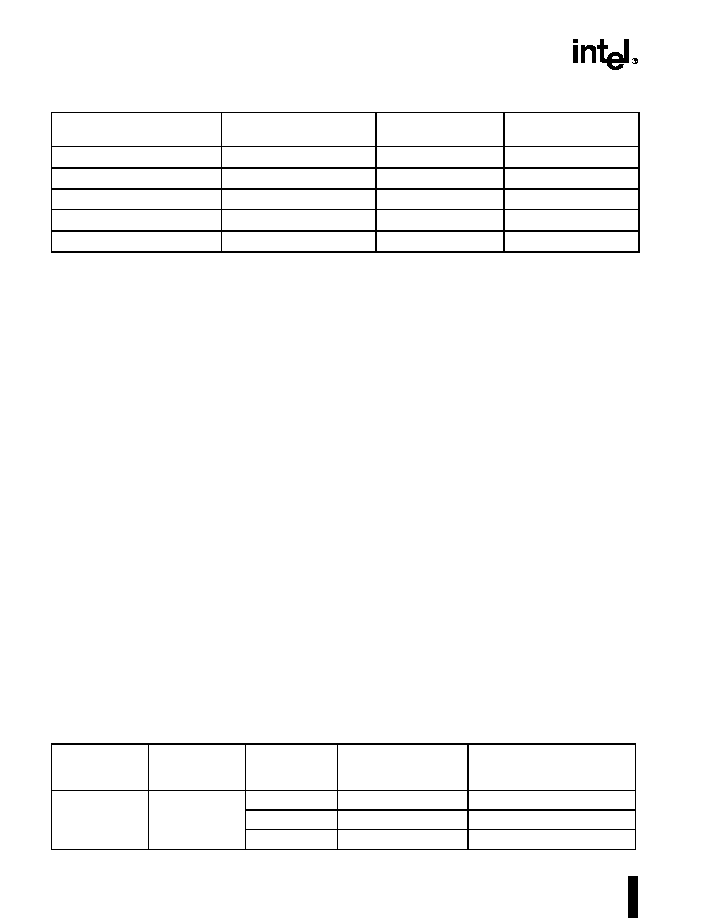
Embedded Write-Back Enhanced IntelDX4TM Processor
26
WB/WT#
HIGH/LOW
Synchronous
Pull-Down
CLKMUL
HIGH
Pull-Up
1
TCK
HIGH
Pull-Up
TDI
HIGH
Pull-Up
TMS
HIGH
Pull-Up
Table 12. Input Pins (Sheet 2 of 2)
Name
Active Level
Synchronous/
Asynchronous
Internal Pull-Up/
Pull-Down
NOTE:
1. Even though STPCLK# and CLKMUL have internal pull-up resistors, they cannot be left floating. An external 10-K
pull-
up resistor is needed if the STPCLK# pin is unused. CLKMUL must be driven to a valid logic level. If tied HIGH, an external
10-K
pull-up resistor is recommended.
4.0
ARCHITECTURAL AND
FUNCTIONAL OVERVIEW
The Embedded Write-Back Enhanced IntelDX4
processor architecture is essentially the same as the
IntelDX4 processor. Refer to the
Embedded
Intel486TM Processor Family Developer's Manual
(273021)
The Embedded Write-Back Enhanced IntelDX4
processor has one pin reserved for possible future
use. This pin, an input signal, is called RESERVED#
and must be connected to a 10-K
pull-up resistor.
The pull-up resistor must be connected only to the
RESERVED# pin. Do not share this resistor with
other pins requiring pull-ups.
4.1
CPUID Instruction
The Embedded Write-Back Enhanced IntelDX4
processor supports the CPUID instruction (see Table
13). Because not all Intel processors support the
CPUID instruction, a simple test can determine if the
instruction is supported. The test involves the
processor's ID Flag, which is bit 21 of the EFLAGS
register. If software can change the value of this flag,
the CPUID instruction is available. The actual state
of the ID Flag bit is irrelevant and provides no signifi-
cance to the hardware. This bit is cleared (reset to
zero) upon device reset (RESET or SRESET) for
compatibility with Intel486 processor designs that do
not support the CPUID instruction.
CPUID-instruction details are provided here for the
Embedded Write-Back Enhanced IntelDX4
processor. Refer to Intel Application Note AP-485
Intel Processor Identification with the CPUID
Instruction
(Order No. 241618) for a description that
covers all aspects of the CPUID instruction and how
it pertains to other Intel processors.
4.1.1
Operation of the CPUID Instruction
The CPUID instruction requires the software
developer to pass an input parameter to the
processor in the EAX register. The processor
response is returned in registers EAX, EBX, EDX,
and ECX.
Table 13. CPUID Instruction Description
OP CODE
Instruction
Processor
Core Clocks
Parameter passed in
EAX
(Input Value)
Description
0F A2
CPUID
9
0
Vendor (Intel) ID String
14
1
Processor Identification
9
> 1
Undefined (Do Not Use)
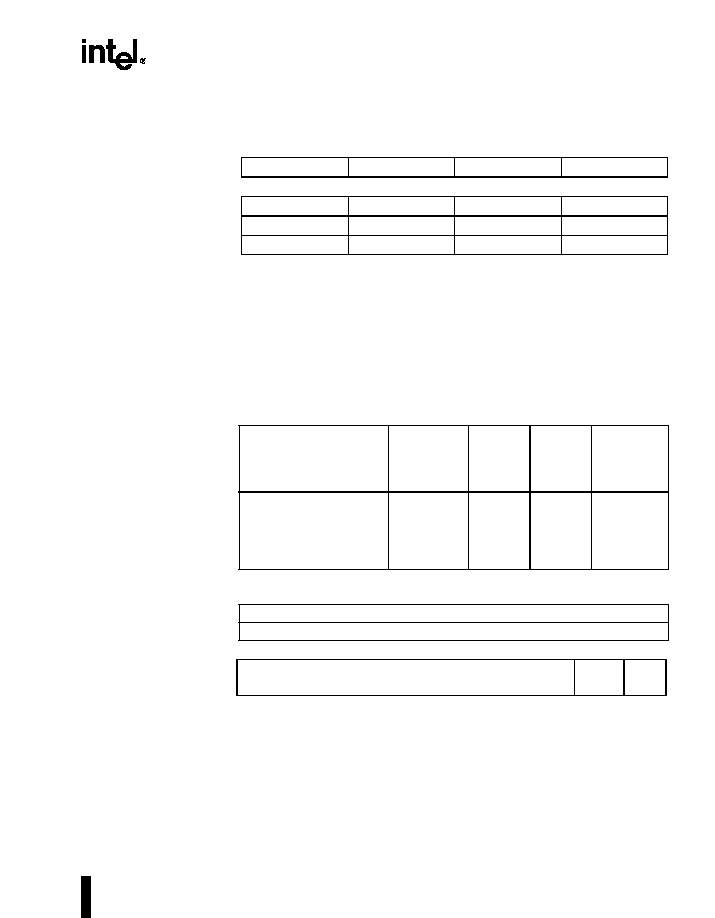
Embedded Write-Back Enhanced IntelDX4TM Processor
27
Vendor ID String - When the parameter passed in EAX is 0 (zero), the register values returned upon
instruction execution are shown in the following table.
The values in EBX, EDX and ECX indicate an Intel processor. When taken in the proper order, they decode to
the string "
GenuineIntel
."
The state of the WB/WT# input pin is sampled by the processor on the falling edge of the RESET signal. If
WB/WT# is LOW, the processor is configured to operate in Write-Through/Standard Bus mode. If HIGH, it is
configured to operate in Write-Back/Enhanced Bus mode. The value of the "Model" field of the processor
signature register depends on the bus mode for which the processor is configured.
Processor Identification - When the parameter passed to EAX is 1 (one), the register values returned upon
instruction execution are:
31-------------24
23-----------16
15--------------8
7--------------0
High Value (= 1)
EAX
0 0 0 0
0 0 0 0
0 0 0 0
0 0 0 1
Vendor ID String
EBX
u
(75)
n
(6E)
e
(65)
G
(47)
(ASCII
EDX
I
(49)
e
(65)
n
(6E)
i
(69)
Characters)
ECX
l
(6C)
e
(65)
t
(74)
n
(6E)
31---------------------------14
13,12
11----8
7----4
3----0
Processor
Signature for
Write-Through/Stan-
dard Bus mode
EAX
(Do Not Use)
Intel Reserved
0 0
Processor
Type
0 1 0 0
Family
1 0 0 0
Model
XXXX
Stepping
Processor
Signature for
Write-
Back/Enhanced Bus
mode
(Do Not Use)
Intel Reserved
0 0
Processor
Type
0 1 0 0
Family
1 0 0 1
Model
XXXX
Stepping
(Intel releases information about stepping numbers as needed)
31--------------------------------------------------------------------------------------------------0
Intel Reserved
EBX
Intel Reserved
(Do Not Use)
ECX
Intel Reserved
31----------------------------------------------------------------------------2
1
0
Feature Flags
EDX
0------------------------------------------------------------------------------0
1
VME
0
FPU
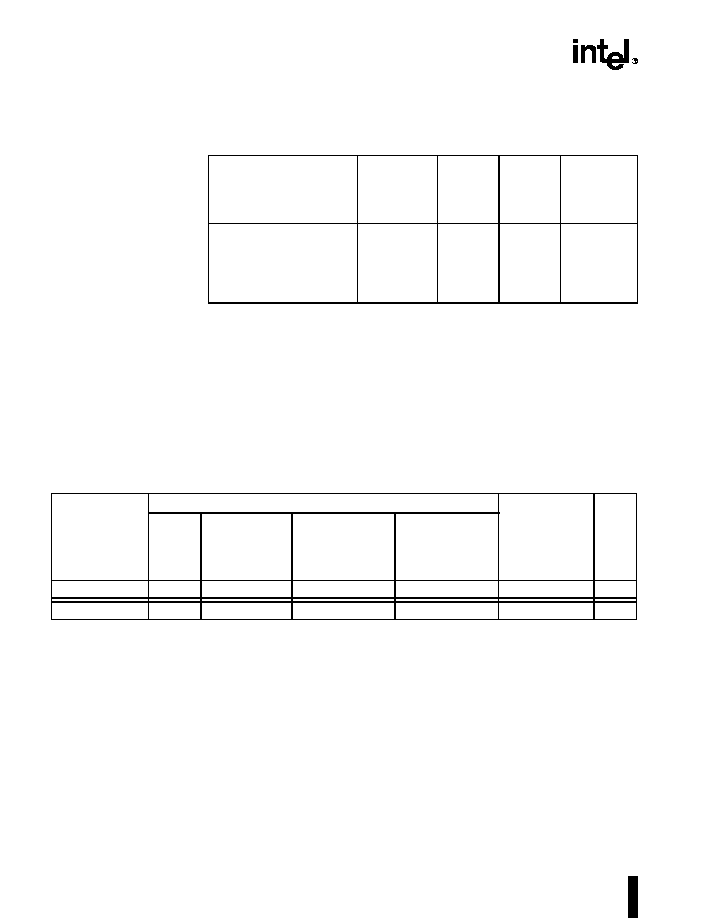
Embedded Write-Back Enhanced IntelDX4TM Processor
28
4.2
Identification After Reset
Processor Identification - Upon reset, the EDX register contains the processor signature:
4.3
Boundary Scan (JTAG)
4.3.1
Device Identification
Tables 14 and 15 show the 32-bit code for the Embedded Write-Back Enhanced IntelDX4 processor. This code
is loaded into the Device Identification Register.
31---------------------------14
13,12
11----8
7----4
3----0
Processor
Signature for
Write-Through/Stan-
dard Bus mode
EDX
(Do Not Use)
Intel Reserved
0 0
Processor
Type
0 1 0 0
Family
1 0 0 0
Model
XXXX
Stepping
Processor
Signature for
Write-
Back/Enhanced Bus
mode
(Do Not Use)
Intel Reserved
0 0
Processor
Type
0 1 0 0
Family
1 0 0 1
Model
XXXX
Stepping
(Intel releases information about stepping numbers as needed)
Table 14. Boundary Scan Component Identification Code (Write-Through/Standard Bus Mode)
Version
Part Number
Mfg ID
009H = Intel
1
V
CC
1=3.3 V
Intel
Architecture
Type
Family
0100 = Intel486
CPU Family
Model
01000 =
Embedded Write-
Back Enhanced
IntelDX4 processor
31----28
27
26-----------21
20----17
16--------12
11------------1
0
XXXX
1
000001
0100
01000
00000001001
1
(Intel releases information about version numbers as needed)
Boundary Scan Component Identification Code = x828 8013 (Hex)

Embedded Write-Back Enhanced IntelDX4TM Processor
29
4.3.2
Boundary Scan Register Bits and Bit
Order
The boundary scan register contains a cell for each
pin as well as cells for control of bidirectional and
three-state pins. There are "Reserved" bits which
correspond to no-connect (N/C) signals of the
Embedded Write-Back Enhanced IntelDX4
processor. Control registers WRCTL, ABUSCTL,
BUSCTL, and MISCCTL are used to select the
direction of bidirectional or three-state output signal
pins. A "1" in these cells designates that the
associated bus or bits are floated if the pins are
three-state, or selected as input if they are bidirec-
tional.
∑ WRCTL controls D31-D0 and DP3≠DP0
∑ ABUSCTL controls A31-A2
∑ BUSCTL controls ADS#, BLAST#, PLOCK#,
LOCK#, W/R#, BE0#, BE1#, BE2#, BE3#, M/IO#,
D/C#, PWT, PCD, and CACHE#
∑ MISCCTL controls PCHK#, HLDA, BREQ, and
HITM#
The following is the bit order of the Embedded Write-
Back Enhanced IntelDX4 processor boundary scan
register:
Table 15. Boundary Scan Component Identification Code (Write-Back/Enhanced Bus Mode)
Version
Part Number
Mfg ID
009H = Intel
1
V
CC
1=3.3 V
Intel
Architecture
Type
Family
0100 = Intel486
CPU Family
Model
01001 =
Embedded Write-
Back Enhanced
IntelDX4 processor
31----28
27
26-----------21
20----17
16--------12
11------------1
0
XXXX
1
000001
0100
01001
00000001001
1
(Intel releases information about version numbers as needed)
Boundary Scan Component Identification Code = x828 9013 (Hex)
TDO
A2, A3, A4, A5, RESERVED#, A6,
A7, A8, A9, A10, A11, A12, A13,
A14, A15, A16, A17, A18, A19,
A20, A21, A22, A23, A24, A25,
A26, A27, A28, A29, A30, A31,
DP0, D0, D1, D2, D3, D4, D5, D6,
D7, DP1, D8, D9, D10, D11, D12,
D13, D14, D15, DP2, D16, D17,
D18, D19, D20, D21, D22, D23,
DP3, D24, D25, D26, D27, D28,
D29, D30, D31, STPCLK#,
IGNNE#, INV, CACHE#, FERR#,
SMI#, WB/WT#, HITM#,
SMIACT#, SRESET, NMI, INTR,
FLUSH#, RESET, A20M#,
EADS#, PCD, PWT, D/C#, M/IO#,
BE3#, BE2#, BE1#, BE0#, BREQ,
W/R#, HLDA, CLK, AHOLD,
HOLD, KEN#, RDY#, CLKMUL,
BS8#, BS16#, BOFF#, BRDY#,
PCHK#, LOCK#, PLOCK#,
BLAST#, ADS#, MISCCTL,
BUSCTL, ABUSCTL, WRCTL
TDI
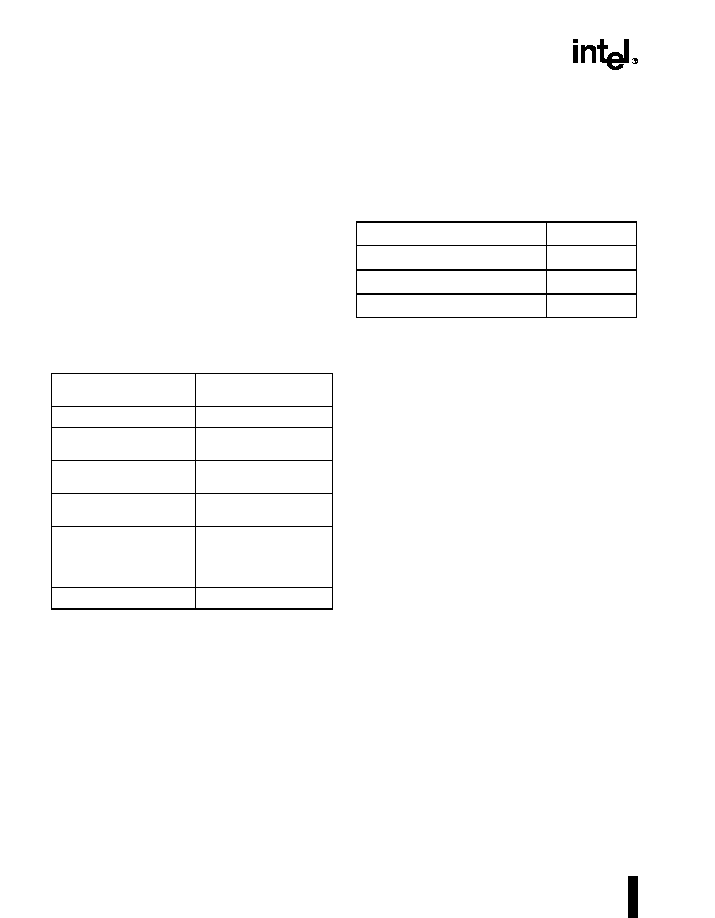
Embedded Write-Back Enhanced IntelDX4TM Processor
30
5.0
ELECTRICAL SPECIFICATIONS
5.1
Maximum Ratings
Table 16 is a stress rating only. Extended exposure
to the Maximum Ratings may affect device reliability.
Furthermore, although the Embedded Write-Back
Enhanced IntelDX4 processorcontains protective
circuitry to resist damage from electrostatic
discharge, always take precautions to avoid high
static voltages or electric fields.
Functional operating conditions are given in Section
5.2, DC Specifications and Section 5.3, AC Speci-
fications.
5.2
DC Specifications
The following tables show the operating supply
voltages, DC I/O specifications, and component
power consumption for the Embedded Write-Back
Enhanced IntelDX4 processor.
Table 16. Absolute Maximum Ratings
Case Temperature under
Bias
-65 ∞C to +110 ∞C
Storage Temperature
-65 ∞C to +150 ∞C
DC Voltage on Any Pin with
Respect to Ground
-0.5 V to V
CC5
+ 0.5 V
Supply Voltage V
CC
with
Respect to V
SS
-0.5 V to +4.6 V
Reference Voltage V
CC5
with
Respect to V
SS
-0.5 V to +6.5 V
Transient Voltage on any
Input
The lesser of:
V
CC5
+ 1.6 V
or
6.5 V
Current Sink on V
CC5
55 mA
Table 17. Operating Supply Voltages
Product
V
CC
FC80486DX4WB75
3.3 V
±
0
.
3 V
FC80486DX4WB100
3.3 V
±
0
.
3 V
A80486DX4WB100
3.3 V
±
0
.
3 V

Embedded Write-Back Enhanced IntelDX4TM Processor
31
Table 18. DC Specifications
Functional Operating Range: V
CC
= 3.3 V
±
0.3 V; V
CC5
= 5 V
±
0.25 V (Note 1); T
CASE
=0 ∞C to +85 ∞C
Symbol
Parameter
Min.
Typ.
Max.
Unit
Notes
V
IL
Input LOW Voltage
-0.3
+0.8
V
V
IH
Input HIGH Voltage
2.0
V
CC5
+0.3
V
Note 2
V
IHC
Input HIGH Voltage of CLK
V
CC5
-0.6
V
CC5
+0.3
V
V
OL
Output LOW Voltage
I
OL
= 4.0 mA (Address, Data, BE
n
)
I
OL
= 5.0 mA (Definition, Control)
I
OL
= 2.0 mA
I
OL
= 100 µA
0.45
0.45
0.40
0.20
V
V
V
V
V
OH
Output HIGH Voltage
I
OH
= -2.0 mA
2.4
V
I
CC5
V
CC5
Leakage Current
15
300
µA
Note 3
I
LI
Input Leakage Current
15
µ
A
Note 4
I
IH
Input Leakage Current
SRESET
200
300
µ
A
µ
A
Note 5
Note 5
I
IL
Input Leakage Current
400
µ
A
Note 6
I
LO
Output Leakage Current
15
µ
A
C
IN
Input Capacitance
10
pF
Note 7
C
OUT
I/O or Output Capacitance
14
pF
Note 7
C
CLK
CLK Capacitance
12
pF
Note 7
NOTES:
1. V
CC5
should be connected to 3.3 V
±
0.3 V in 3.3 V-only systems.
2. All inputs except CLK.
3. This parameter is for inputs without pull-up or pull-down resistors and 0V
V
IN
V
CC
.
4. This parameter is for V
CC5
≠ V
CC
2.25 V. Typical value is not 100% tested.
5. This parameter is for inputs with pull-down resistors and V
IH
= 2.4V.
6. This parameter is for inputs with pull-up resistors and V
IL
= 0.4V.
7. F
C
=1 MHz. Not 100% tested.

Embedded Write-Back Enhanced IntelDX4TM Processor
32
Table 19. I
CC
Values
Functional Operating Range: V
CC
= 3.3 V ±0.3 V; V
CC5
= 5 V
±
0.25 V (Note 1); T
CASE
= 0
∞
C to +85
∞
C
Parameter
Operating
Frequency
Typ.
Maximum
Notes
I
CC
Active
(Power Supply)
75 MHz
100 MHz
1100 mA
1450 mA
Note 2
I
CC
Active
(Thermal Design)
75 MHz
100 MHz
825 mA
1075 mA
975 mA
1300 mA
Notes 3, 4, 5
I
CC
Stop Grant
75 MHz
100 MHz
20 mA
50 mA
75 mA
100 mA
Note 6
I
CC
Stop Clock
0 MHz
600 µA
2 mA
Note 7
NOTES:
1. V
CC5
should be connected to 3.3 V
±
0.3 V in 3.3 V-only systems.
2. This parameter is for proper power supply selection. It is measured using the worst case instruction mix at V
CC
= 3.6V.
3. The maximum current column is for thermal design power dissipation. It is measured using the worst case instruction mix
at V
CC
= 3.3V.
4. The typical current column is the typical operating current in a system. This value is measured in a system using a typical
device at V
CC
= 3.3V, running Microsoft Windows 3.1 at an idle condition. This typical value is dependent upon the specific
system configuration.
5. Typical values are not 100% tested.
6. The I
CC
Stop Grant specification refers to the I
CC
value once the Embedded Write-Back Enhanced IntelDX4 processor
enters the Stop Grant or Auto HALT Power Down state.
7. The I
CC
Stop Clock specification refers to the I
CC
value once the Embedded Write-Back Enhanced IntelDX4 processor
enters the Stop Clock state. The V
IH
and V
IL
levels must be equal to V
CC
and 0 V, respectively, in order to meet the I
CC
Stop Clock specifications.

Embedded Write-Back Enhanced IntelDX4TM Processor
33
5.3
AC Specifications
The AC specifications for the Embedded Write-Back Enhanced IntelDX4 processor are given in this section.
Table 20. AC Characteristics
V
CC
= 3.3 V ± 0.3 V; V
CC5
= 5 V
±
0.25 V (Note 1)
T
CASE
= 0
∞
C to +85
∞
C; C
L
= 50pF, unless otherwise specified. (Sheet 1 of 2)
Symbol
Parameter
Product
WB75
WB100
Min
Max
Min
Max
Unit
Figure
Notes
CLK Frequency
8
25
8
33
MHz
Note 2
t
1
CLK Period
40
125
30
125
ns
4
t
1a
CLK Period Stability
±
250
±
250
ps
4
Adjacent
clocks
Note 3
t
2
CLK High Time
14
11
ns
4
at 2V
t
3
CLK Low Time
14
11
ns
4
at 0.8V
t
4
CLK Fall Time
4
3
ns
4
2V to 0.8V
t
5
CLK Rise Time
4
3
ns
4
0.8V to 2V
t
6
A31≠A2, PWT, PCD, BE3≠BE0#,
M/IO#, D/C#, W/R#, ADS#, LOCK#,
FERR#, CACHE#, HITM#, BREQ,
HLDA Valid Delay
3
19
3
14
ns
8
t
7
A31≠A2, PWT, PCD, BE3≠BE0#,
M/IO#, D/C#, W/R#, ADS#, LOCK#,
CACHE# Float Delay
28
20
ns
9
Note 3
t
8
PCHK# Valid Delay
3
24
3
14
ns
7
t
8a
BLAST#, PLOCK#, SMIACT# Valid
Delay
3
24
3
14
ns
8
t
9
BLAST#, PLOCK# Float Delay
28
20
ns
9
Note 3
t
10
D31≠D0, DP3≠DP0 Write Data Valid
Delay
3
20
3
14
ns
8
t
11
D31≠D0, DP3≠DP0 Write Data Float
Delay
28
20
ns
9
Note 3
t
12
EADS#, INV Setup Time
8
5
ns
5
t
13
EADS#, INV Hold Time
3
3
ns
5
t
14
KEN#, BS16#, BS8#, WB/WT# Setup
Time
8
5
ns
5
t
15
KEN#, BS16#, BS8#, WB/WT# Hold
Time
3
3
ns
5
t
16
RDY#, BRDY# Setup Time
8
5
ns
6
t
17
RDY#, BRDY# Hold Time
3
3
ns
6

Embedded Write-Back Enhanced IntelDX4TM Processor
34
t
18
HOLD, AHOLD Setup Time
8
6
ns
5
t
18a
BOFF# Setup Time
8
7
ns
5
t
19
HOLD, AHOLD, BOFF# Hold Time
3
3
ns
5
t
20
FLUSH#, A20M#, NMI, INTR, SMI#,
STPCLK#, SRESET, RESET,
IGNNE# Setup Time
8
5
ns
5
Note 4
t
21
FLUSH#, A20M#, NMI, INTR, SMI#,
STPCLK#, SRESET, RESET,
IGNNE# Hold Time
3
3
ns
5
Note 4
t
22
D31≠D0, DP3≠DP0,
A31≠A4 Read Setup Time
5
5
ns
6
5
t
23
D31≠D0, DP3≠DP0,
A31≠A4 Read Hold Time
3
3
ns
6
5
NOTES:
1. V
CC5
should be connected to 3.3 V
±
0.3 V in 3.3 V-only systems.
2. 0-MHz operation is guaranteed when the STPCLK# and Stop Grant bus cycle protocol is used.
3. Not 100% tested, guaranteed by design characterization.
4. A reset pulse width of 15 CLK cycles is required for warm resets (RESET or SRESET). Power-up resets (cold resets)
require RESET to be asserted for at least 1 ms after V
CC
and CLK are stable.
Table 20. AC Characteristics
V
CC
= 3.3 V ± 0.3 V; V
CC5
= 5 V
±
0.25 V (Note 1)
T
CASE
= 0
∞
C to +85
∞
C; C
L
= 50pF, unless otherwise specified. (Sheet 2 of 2)
Symbol
Parameter
Product
WB75
WB100
Min
Max
Min
Max
Unit
Figure
Notes

Embedded Write-Back Enhanced IntelDX4TM Processor
35
Table 21. AC Specifications for the Test Access Port
V
CC
= 3.3 V ±0.3 V; V
CC5
= 5 V
±
0.25 V (Note 1)
T
CASE
= 0
∞
C to +85
∞
C; C
L
= 50 pF
Symbol
Parameter
Min
Max
Unit
Figure
Notes
t
24
TCK Frequency
25
MHz
Note 2
t
25
TCK Period
40
ns
10
t
26
TCK High Time
10
ns
10
@ 2.0V
t
27
TCK Low Time
10
ns
10
@ 0.8V
t
28
TCK Rise Time
4
ns
10
Note 3
t
29
TCK Fall Time
4
ns
10
Note 3
t
30
TDI, TMS Setup Time
8
ns
11
Note 4
t
31
TDI, TMS Hold Time
7
ns
11
Note 4
t
32
TDO Valid Delay
3
25
ns
11
Note 4
t
33
TDO Float Delay
30
ns
11
Note 4
t
34
All Outputs (except TDO) Valid Delay
3
25
ns
11
Note 4
t
35
All Outputs (except TDO) Float Delay
36
ns
11
Note 4
t
36
All Inputs (except TDI, TMS, TCK) Setup Time
8
ns
11
Note 4
t
37
All Inputs (except TDI, TMS, TCK) Hold Time
7
ns
11
Note 4
NOTES:
1. V
CC5
should be connected to 3.3 V
±
0.3 V in 3.3 V-only systems. All inputs and outputs are TTL level.
2. TCK period
CLK period.
3. Rise/Fall times are measured between 0.8V and 2.0V. Rise/Fall times can be relaxed by 1 ns per 10-ns increase in TCK
period.
4. Parameters t
30 ≠
t
37
are measured from TCK.
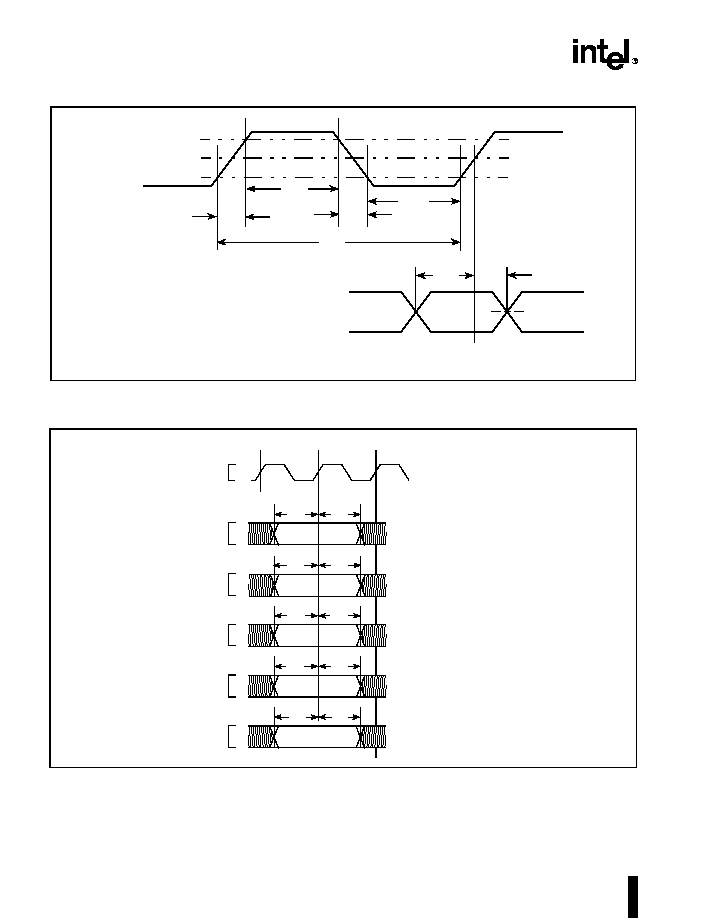
Embedded Write-Back Enhanced IntelDX4TM Processor
36
Figure 4. CLK Waveform
Figure 5. Input Setup and Hold Timing
1.5 V
t
1
t
5
t
2
t
4
t
3
0.8 V
CLK
2.0 V
t
x
t
y
1.5 V
t
x
= input setup times
t
y
= input hold times, output float, valid and hold times
1.5 V
0.8 V
2.0 V
T
x
T
x
T
x
T
x
CLK
INV, EADS#
BS8#, BS16#,
BOFF#, AHOLD, HOLD
RESET, FLUSH#,
A31-A4
(READ)
A20M#, INTR, NMI, SMI#,
STPCLK#, SRESET, IGNNE#
t
12
t
14
t
13
t
15
t
18
t
19
t
20
t
21
t
22
t
23
KEN#, WB/WT#
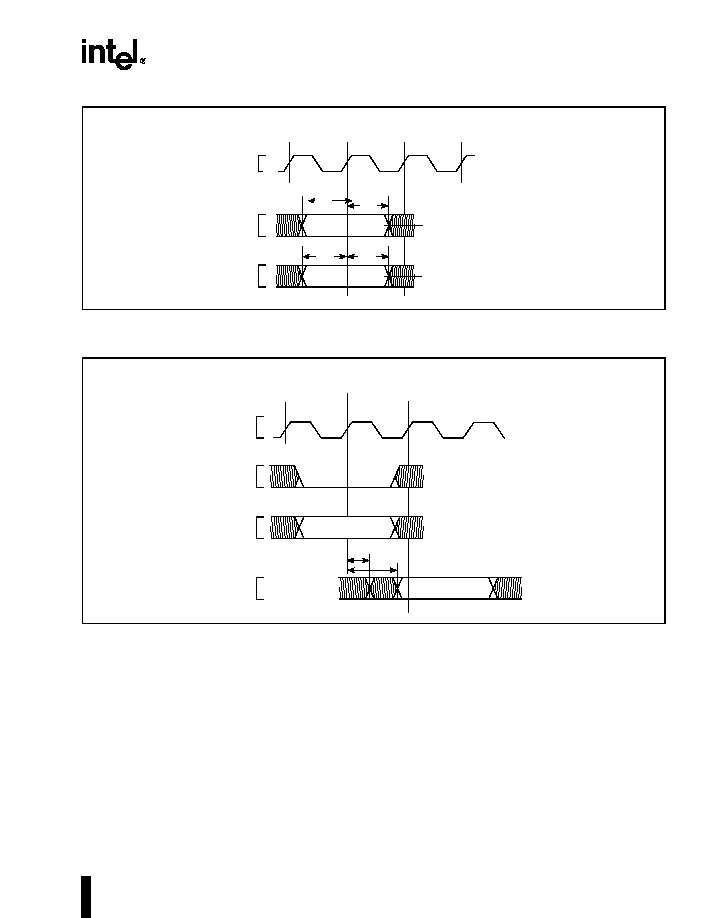
Embedded Write-Back Enhanced IntelDX4TM Processor
37
Figure 6. Input Setup and Hold Timing
Figure 7. PCHK# Valid Delay Timing
T
2
T
x
CLK
RDY#, BRDY#
D31-D0, DP3≠DP0
T
x
1.5 V
1.5 V
t
16
t
17
t
22
t
23
RDY#, BRDY#
D31-D0
DP3-DP0
VALID
MIN
MAX
t
8
PCHK#
T
2
T
x
T
x
T
x
CLK
VALID

Embedded Write-Back Enhanced IntelDX4TM Processor
38
Figure 8. Output Valid Delay Timing
Figure 9. Maximum Float Delay Timing
SMIACT#, BLAST#,
PLOCK#
T
x
T
x
T
x
T
x
CLK
A2-A31, PWT, PCD,
D31-D0, DP3≠DP0
VALID n+1
MAX
t
6
VALID n
t
10
t
8a
BE0-3#, M/IO#,
D/C#, W/R#, ADS#,
LOCK#, BREQ, HLDA,
VALID n+1
MIN
MAX
VALID n
VALID n+1
MIN
MAX
VALID n
MIN
FERR#, CACHE#, HITM#
T
x
T
x
T
x
CLK
A2-A31, PWT, PCD,
D31-D0, DP3≠DP0
BLAST#,
MIN
t
6
VALID
BE0-3#, M/IO#,
D/C#, W/R#, ADS#,
LOCK#, CACHE#
PLOCK#
t
7
t
10
t
11
t
8a
t
9
MIN
VALID
MIN
VALID
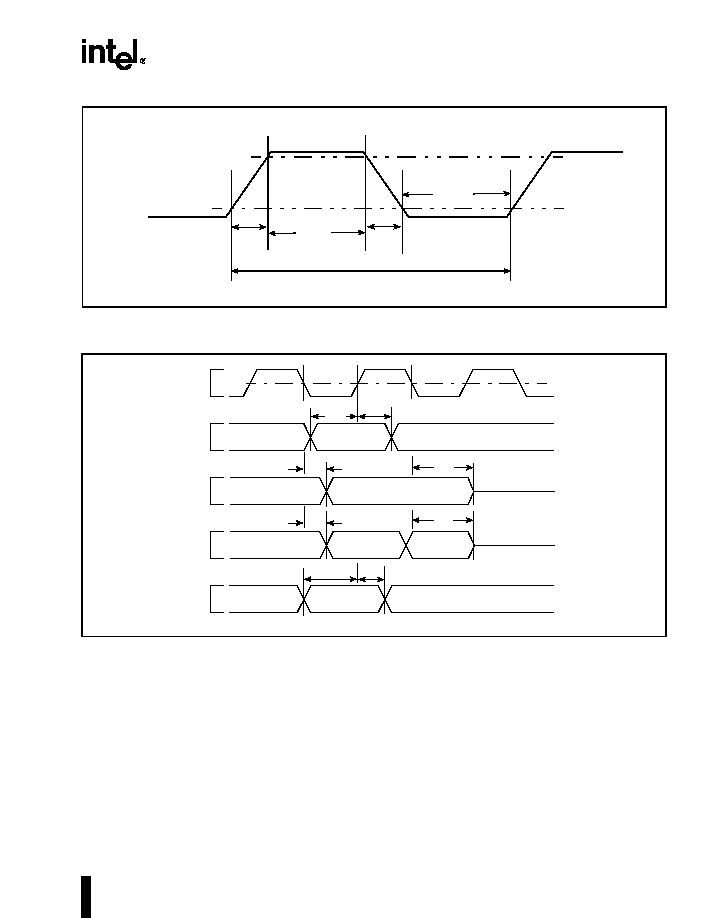
Embedded Write-Back Enhanced IntelDX4TM Processor
39
Figure 10. TCK Waveform
Figure 11. Test Signal Timing Diagram
0.8 V
t
26
t
25
2.0 V
TCK
t
27
t
28
t
29
0.8 V
2.0 V
t
31
t
30
TCK
TMS
TDI
TDO
OUTPUT
INPUT
VALID
t
32
t
33
VALID
t
35
VALID
VALID
VALID
t
34
t
37
t
36
1.5 V
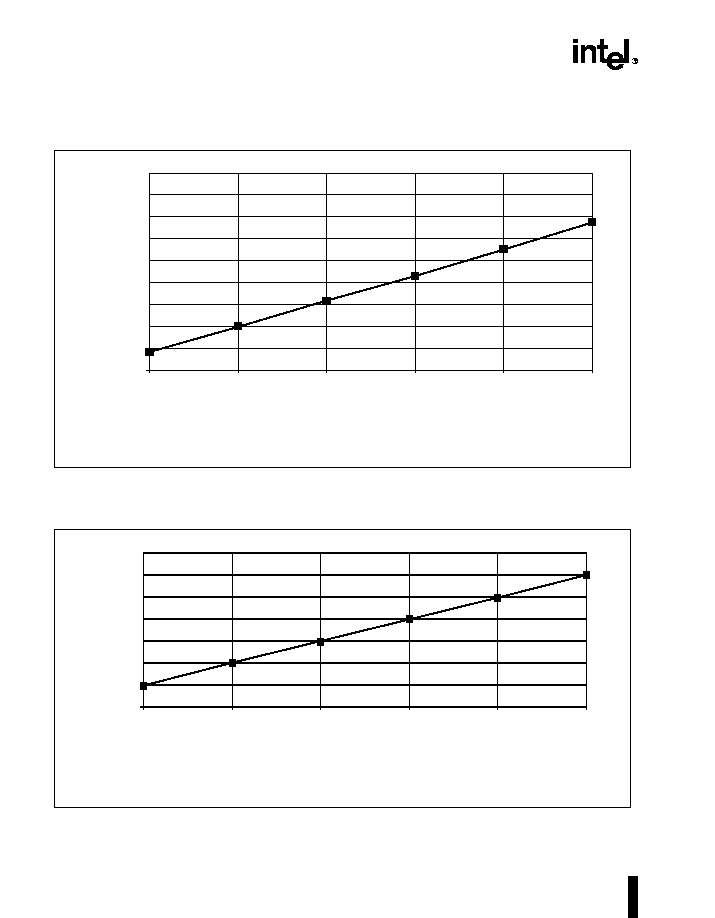
Embedded Write-Back Enhanced IntelDX4TM Processor
40
5.4
Capacitive Derating Curves
These graphs are the capacitive derating curves for the Embedded Write-Back Enhanced IntelDX4 processor.
Figure 12. Typical Loading Delay versus Load Capacitance under Worst-Case Conditions
for a Low-to-High Transition
Figure 13. Typical Loading Delay versus Load Capacitance under Worst-Case Conditions
for a High-to-Low Transition
nom+5
nom+4
nom+3
nom+2
nom+1
nom
nom-1
nom-2
Delay (ns)
Note: This graph will not be linear outside of the capacitive range shown.
nom = nominal value from the AC Characteristics table.
Capacitive Load (pF)
25
50
75
100
125
150
nom+7
nom+6
A3238-01
nom+5
nom+4
nom+3
nom+2
nom+1
nom
nom-1
nom-2
Delay (ns)
Note: This graph will not be linear outside of the capacitive range shown.
nom = nominal value from the AC Characteristics table.
Capacitive Load (pF)
25
50
75
100
125
150
A3237-01
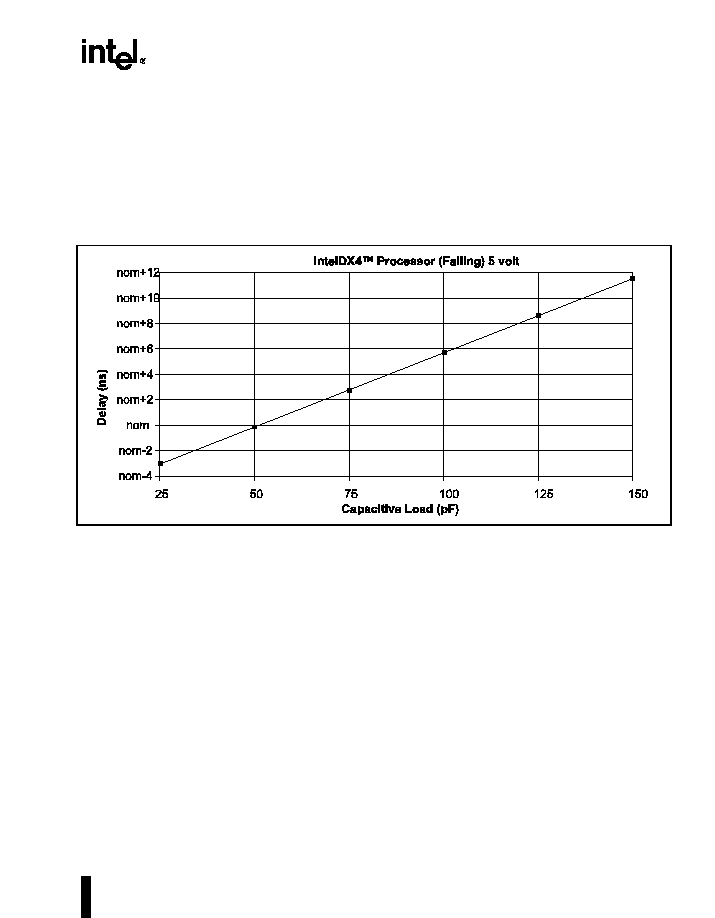
41
Embedded Write-Back Enhanced IntelDX4TM Processor
In a mixed voltage system (processors at 3 volts,
peripherals at 5 volts), the bus is driven to 5 volts by
the peripheral logic. Therefore, the processor must
discharge the capacitance on the bus from 5 volts to
0 volts, which takes more time than the 3 volts to 0
volts transition. Inaccurate capacitive derating
impacts timing margins and may result in system
failures under certain load conditions
.
When designing for higher loads in mixed voltage
systems, timing margins should be evaluated based
on the derating curves shown in Figure 14. For more
accurate delay prediction, use I/O buffer models.
Figure 14. Typical Loading Delay versus Load Capacitance in Mixed Voltage System
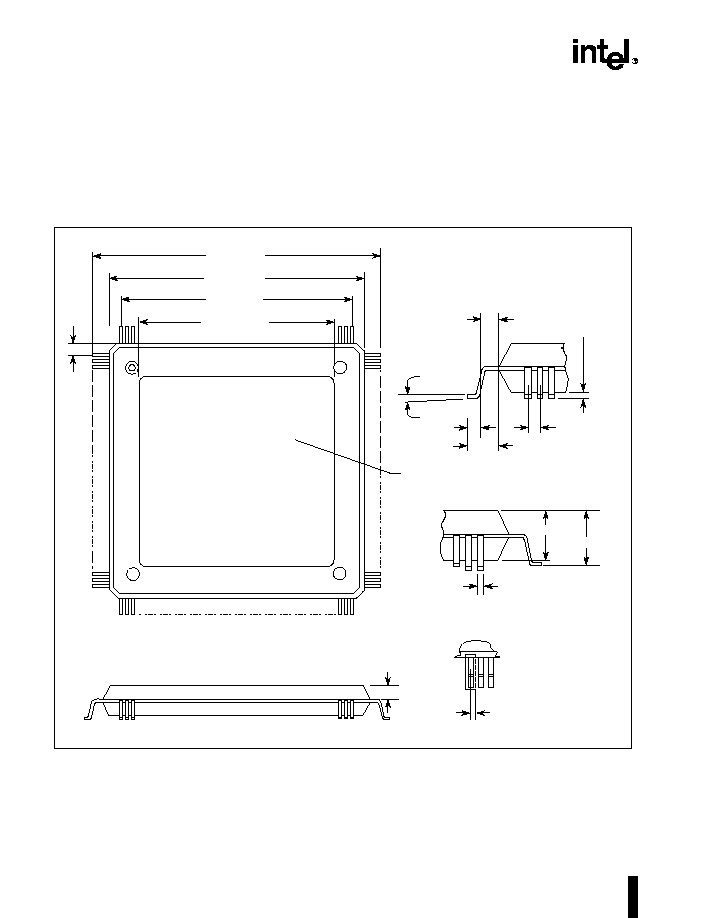
Embedded Write-Back Enhanced IntelDX4TM Processor
42
6.0
MECHANICAL DATA
This section describes the packaging dimensions and thermal specifications for the Embedded Write-Back
Enhanced IntelDX4 processor.
6.1
Package Dimensions
Figure 15. 208-Lead SQFP Package Dimensions
A3260-01
1.14
(ref)
28.0 ± 0.10
30.6 ± 0.25
25.50 (ref)
21.20 ± 0.10
208
157
156
105
104
53
52
NOTE: Length measurements same as width measurements
0.50
0.13 + 0.12-0.08
0∞ Min
7∞ Max
0.60 ± 0.10
3.37 ± 0.08
3.70 Max
0.13 Min
0.25 Max
Metal Heat Spreader
1.76 Max
0.10 Max
Tolerance Window for
Lead Skew from Theoretical
True Position
1.30 Ref
.40 Min
Top View
1
Units: mm

Embedded Write-Back Enhanced IntelDX4TM Processor
43
Figure 16. Principal Dimensions and Data for 168-Pin Grid Array Package
Table 22. 168-Pin Ceramic PGA Package Dimensions
Symbol
Millimeters
Inches
Min
Max
Notes
Min
Max
Notes
A
3.56
4.57
0.140
0.180
A
1
0.64
1.14
SOLID LID
0.025
0.045
SOLID LID
A
2
2.8
3.5
SOLID LID
0.110
0.140
SOLID LID
A
3
1.14
1.40
0.045
0.055
B
0.43
0.51
0.017
0.020
D
44.07
44.83
1.735
1.765
D
1
40.51
40.77
1.595
1.605
e
1
2.29
2.79
0.090
0.110
L
2.54
3.30
0.100
0.130
N
168
168
S
1
1.52
2.54
0.060
0.100

Embedded Write-Back Enhanced IntelDX4TM Processor
44
Table 23. Ceramic PGA Package Dimension Symbols
Letter or Symbol
Description of Dimensions
A
Distance from seating plane to highest point of body
A
1
Distance between seating plane and base plane (lid)
A
2
Distance from base plane to highest point of body
A
3
Distance from seating plane to bottom of body
B
Diameter of terminal lead pin
D
Largest overall package dimension of length
D
1
A body length dimension, outer lead center to outer lead center
e
1
Linear spacing between true lead position centerlines
L
Distance from seating plane to end of lead
S
1
Other body dimension, outer lead center to edge of body
NOTES:
1. Controlling dimension: millimeter.
2. Dimension "e
1
" ("e") is non-cumulative.
3. Seating plane (standoff) is defined by P.C. board hole size: 0.0415≠0.0430 inch.
4. Dimensions "B", "B
1
" and "C" are nominal.
5. Details of Pin 1 identifier are optional.
6.2
Package Thermal Specifications
The Embedded Write-Back Enhanced IntelDX4
processoris specified for operation when the case
temperature (T
C
) is within the range of 0∞C to 85∞C.
T
C
may be measured in any environment to
determine whether the processor is within the
specified operating range.
The ambient temperature (T
A
) can be calculated
from
JC
and
JA
from the following equations:
T
J
= T
C
+ P *
JC
T
A
= T
J
- P *
JA
T
C
= T
A
+ P * [
JA
-
JC
]
T
A
= T
C
- P * [
JA
-
JC
]
Where T
J
, T
A
, T
C
equals Junction, Ambient and
Case Temperature respectively.
JC
,
JA
equals
Junction-to-Case and Junction-to-Ambient thermal
Resistance, respectively. P is defined as Maximum
Power Consumption.
Values for
JA
and
JC
are given in the following
tables for each product at its maximum operating
frequencies. Maximum T
A
is shown for each product
operating at its maximum processor frequency (three
times the CLK frequency). Refer to the
Embedded
Intel486TM Processor Family Developer's Manual
(273021) for a description of the methods used to
measure these characteristics.
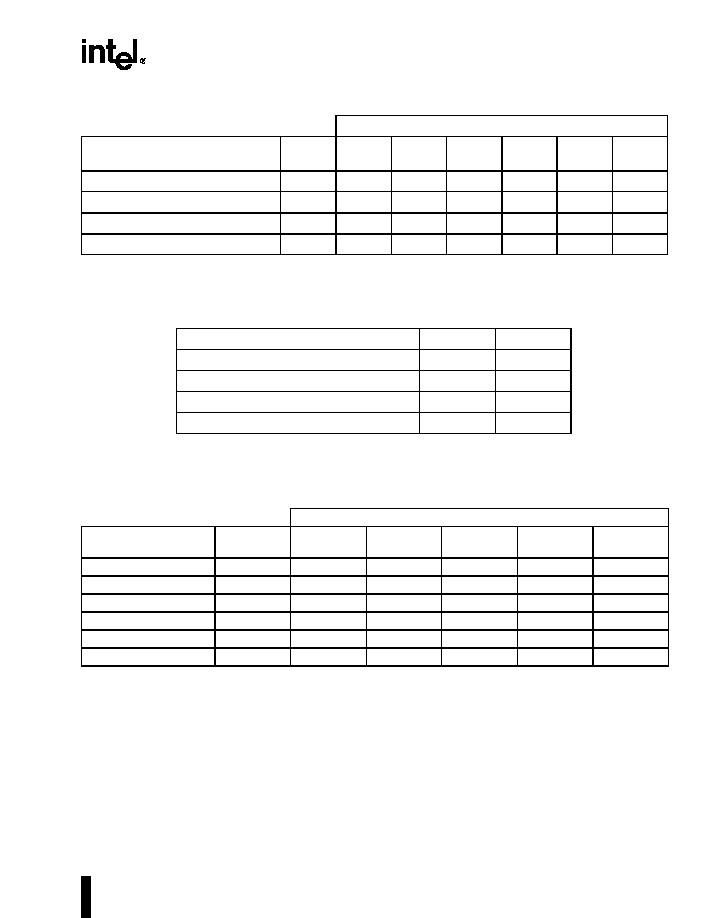
Embedded Write-Back Enhanced IntelDX4TM Processor
45
Table 24. Thermal Resistance,
JA
(
∞
C/W)
JA
vs. Airflow -- ft/min. (m/sec)
Package
Heat
Sink
0
(0)
200
(1.01)
400
(2.03)
600
(3.04)
800
(4.06)
1000
(5.07)
168-Pin PGA
No
17.5
15.0
13.0
11.5
10.0
9.5
168-Pin PGA
Yes
13.5
8.5
6.5
5.5
4.5
4.25
208-Lead SQFP
No
12.5
10.0
9.0
8.5
208-Lead SQFP
Yes
10.5
6.5
5.0
4.0
Table 25. Thermal Resistance,
JC
(
∞
C/W)
Package
Heat Sink
JC
168-Pin PGA
No
2.0
168-Pin PGA
Yes
2.0
208-Lead SQFP
No
1.2
208-Lead SQFP
Yes
0.8
Table 26. Maximum T
ambient,
T
A
max (
∞
C)
Airflow -- ft/min. (m/sec)
Package
Heat Sink
Freq.
(MHz)
0
(0)
200
(1.01)
400
(2.03)
600
(3.04)
168-Pin PGA
No
100
18.5
29.0
37.5
44.0
168-Pin PGA
Yes
100
35.5
57.0
65.5
70.0
208-Lead SQFP
No
100
36.5
46.0
50.0
52.5
208-Lead SQFP
Yes
100
43.5
60.5
67.0
71.0
208-Lead SQFP
No
75
208-Lead SQFP
Yes
75

















































